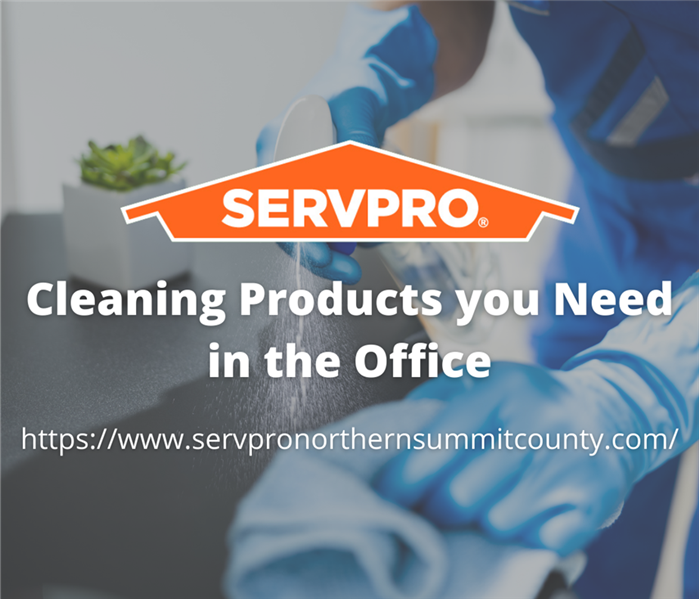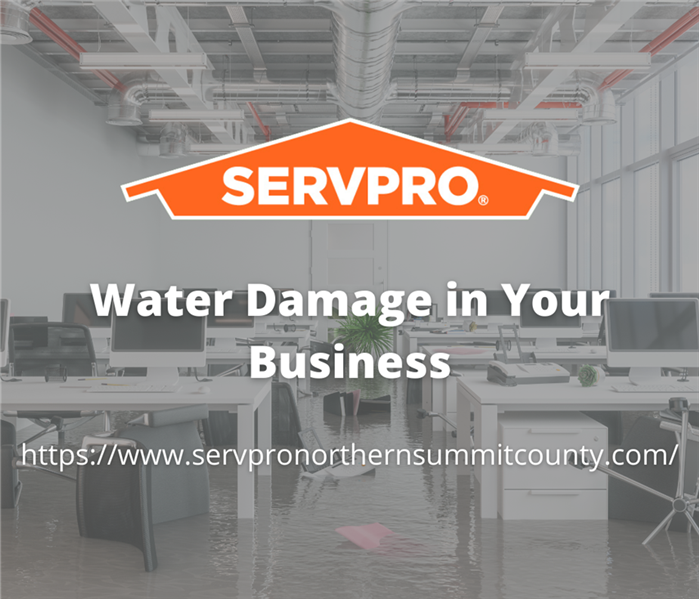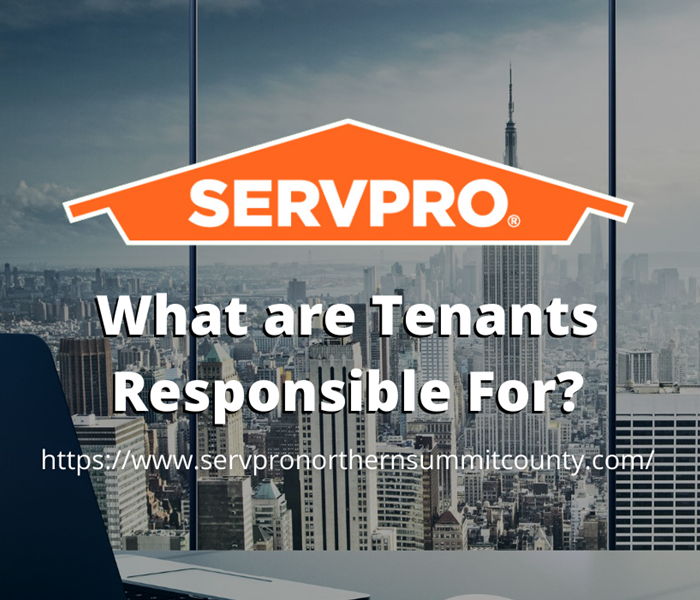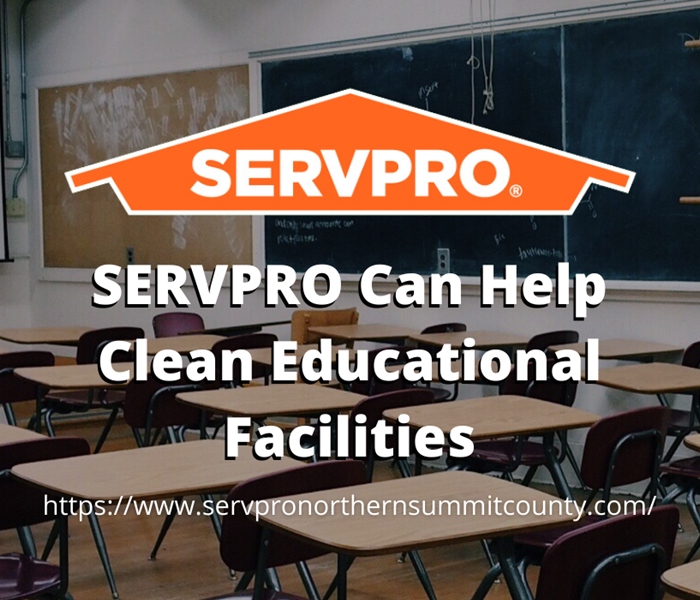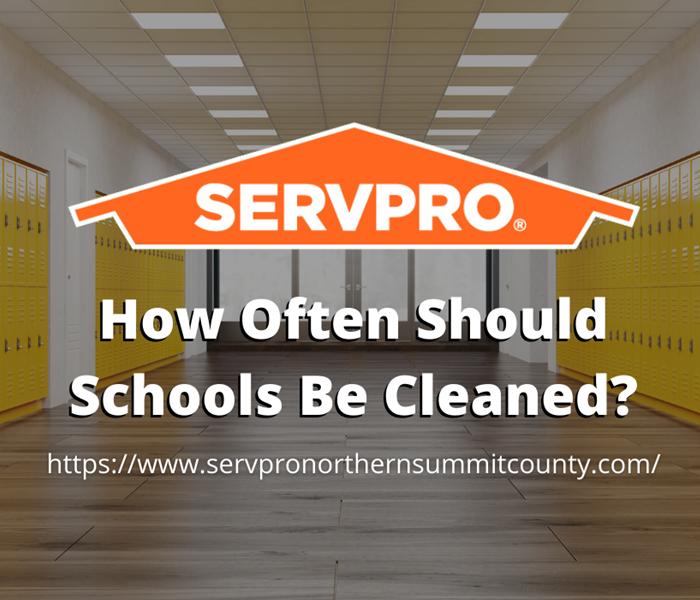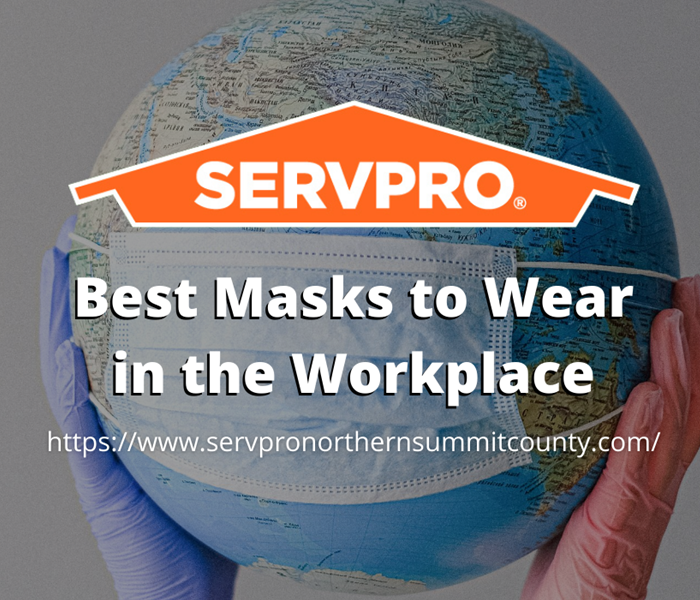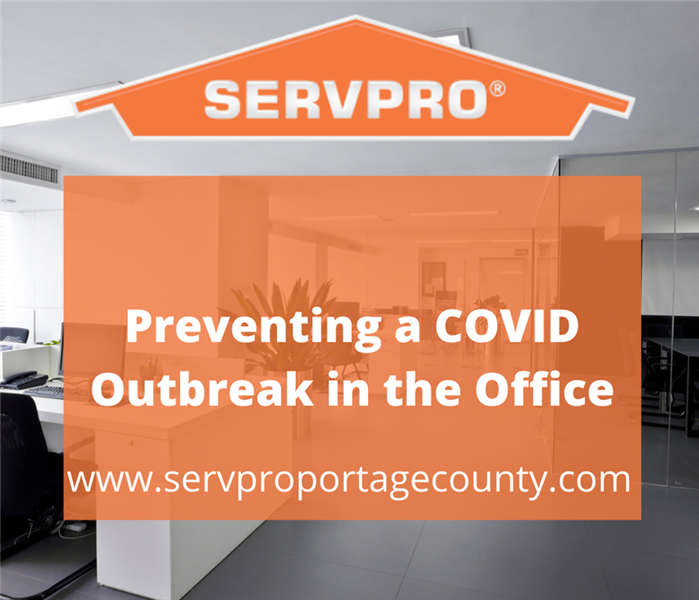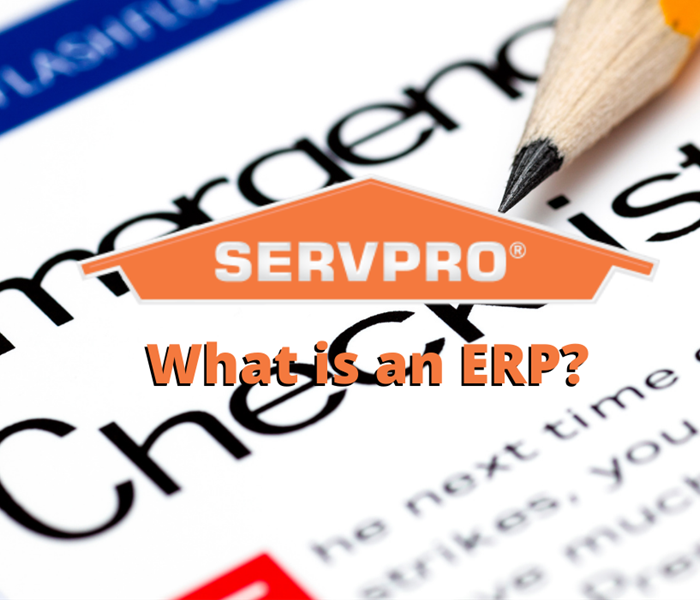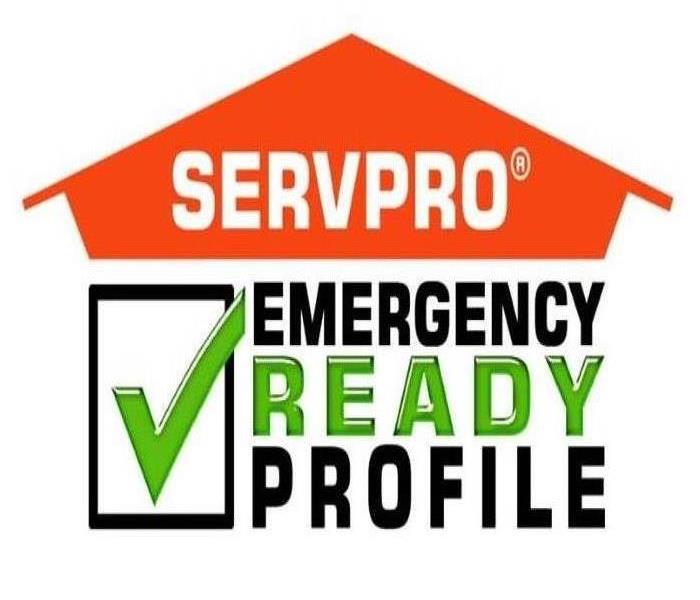Recent Commercial Posts
The Importance of a Simple Emergency Plan for Commercial Companies
8/2/2024 (Permalink)
 In the fast-paced world of commercial businesses, unexpected emergencies can strike at any time.
Even the best trained staff needs a simple plan.
In the fast-paced world of commercial businesses, unexpected emergencies can strike at any time.
Even the best trained staff needs a simple plan.
In the fast-paced world of commercial businesses, unexpected emergencies can strike at any time. Whether it's a natural disaster, a fire, a medical emergency, or a security threat, being prepared is crucial. Even the most well-trained staff can find it challenging to think clearly and make quick decisions during chaotic situations. That's why having a simple, easy-to-follow emergency plan is essential. A straightforward plan can help offset the brain's ability to process information in high-stress scenarios and ensure the safety of employees, customers, and assets. Here's why planning ahead is beneficial for your business.
- Clarity in Chaos
Emergencies can overwhelm the senses and make it difficult to think clearly. A simple emergency plan provides clear, concise steps for everyone to follow, minimizing confusion and panic. When employees know exactly what to do, they can act quickly and efficiently, reducing the risk of injury and damage.
- Improved Response Time
In an emergency, every second counts. A well-defined plan can significantly improve response times by providing immediate guidance. Quick action can prevent minor issues from escalating into major crises, saving lives and reducing potential losses. For example, a clear evacuation plan can ensure everyone exits the building safely and promptly during a fire.
- Increased Safety for Employees and Customers
The safety of employees and customers is paramount. A simple emergency plan prioritizes their well-being by outlining evacuation routes, identifying safe zones, and designating roles and responsibilities. When everyone knows their part, they can act in an organized manner, helping to prevent injuries and ensuring a swift, safe response.
- Minimized Business Disruption
Emergencies can disrupt business operations, leading to lost revenue and productivity. By planning ahead, companies can minimize downtime and ensure a quicker return to normal operations. For instance, having a plan for data backup and recovery can protect critical business information and facilitate a smooth transition to temporary work arrangements if needed.
- Enhanced Communication
Clear communication is critical during an emergency. A simple plan establishes communication protocols, ensuring that everyone knows how to relay important information and receive updates. This includes designating a point of contact, establishing a communication chain, and utilizing multiple channels, such as email, phone, and text alerts, to reach all employees and stakeholders.
- Compliance and Liability Reduction
In many industries, having an emergency plan is not just a best practice; it's a regulatory requirement. Compliance with safety regulations protects your business from legal liabilities and potential fines. A well-documented plan demonstrates your commitment to safety and can be crucial in the event of an investigation or legal inquiry.
- Peace of Mind
Knowing that there is a plan in place can provide peace of mind to both management and staff. It fosters a sense of security and confidence, knowing that the company is prepared to handle emergencies effectively. This can improve morale and reduce anxiety, allowing employees to focus on their work without fear of the unknown.
Creating a Simple Emergency Plan
To create an effective emergency plan, follow these key steps:
- Identify Potential Risks: Assess the types of emergencies that could impact your business, such as natural disasters, fires, medical emergencies, or security threats.
- Develop Clear Procedures: Outline step-by-step procedures for each type of emergency, including evacuation routes, emergency contacts, and specific roles for employees.
- Train Your Staff: Regularly train employees on the emergency plan and conduct drills to reinforce the procedures. Ensure that everyone understands their responsibilities and knows how to respond.
- Communicate the Plan: Make the plan easily accessible to all employees and communicate it regularly. Use visual aids, such as maps and diagrams, to illustrate key information.
- Review and Update: Regularly review and update the plan to reflect changes in your business, new risks, or updates in regulations. Continuous improvement ensures that your plan remains effective and relevant.
SERVPRO's Emergency Ready Plan
For commercial properties, having a reliable and accessible emergency plan is vital. SERVPRO's Emergency Ready Plan provides an easy-to-use format that helps businesses prepare for the unexpected. This comprehensive tool allows you to outline critical information, including emergency contacts, facility details, and shut-off locations for utilities. By having all essential information in one place, you can ensure a swift and efficient response during an emergency, minimizing damage and disruption.
Conclusion
Emergencies are unpredictable, but a simple, well-prepared emergency plan can make all the difference. By providing clear guidance and training, businesses can protect their employees, customers, and assets, while minimizing disruption and ensuring a swift recovery. Planning ahead is not just a precaution—it's a critical component of responsible business management. Don't wait for an emergency to strike; start planning today with SERVPRO's Emergency Ready Plan and ensure the safety and resilience of your company. Contact our team for more information 330-650-4486
Cleaning Products you Need in the Office
4/4/2022 (Permalink)
When it comes to office cleaning and maintenance, it is essential that you have all the proper cleaning supplies to get it done. Here are some things every office will need:
The first thing you should get for office cleaning is a broom, dustpan, and maybe even a vacuum cleaner. This is especially important if you have a high-traffic office where employees and customers are constantly coming in and out and tracking dirt and debris with them.
The next cleaning supply you should get is electronic wipes. Almost every office nowadays is completely paperless so the devices tend to get dirty and grimy. Keeping wipes on hand will allow employees to clean their devices at the end of the day.
The last essential cleaning supply is an all-purpose cleaner. This can be used to clean counters, desks, kitchen areas, and even door handles!
Water Damage in Your Business
3/2/2022 (Permalink)
Water damage in your business is devastating in multiple ways and may happen unexpectedly. But there are ways to be prepared in the event of water damage, and there are steps that SERVPRO will take to help to restore your business.
Be Prepared
The best way to prevent water damage is to be prepared before it even happens. SERVPRO offers an Emergency Ready Plan. This plan has many advantages, it offers a no-cost assessment of your facility, a concise profile document that only contains critical information, a guide for getting into your building following a disaster, and many more advantages. So, the best way to prevent water damage in your business is to be prepared and to have a plan.
Tips for Minimizing Damages
Shut off the water source if possible.
Remove as much excess water as possible by mopping and blotting.
If your business has carpet, rugs, or upholstered items, make sure they are protected. You can place aluminum foil or wood blocks between furniture legs and wet carpeting to help to protect them to the best of your ability.
Remove any books, magazines, or other colored items from the floor, carpet, or rugs.
Don’t enter affected areas if there are electrical outlets, switches, circuit breakers, or electrical equipment, and avoid using electric or electronic items that may have come in contact with the water.
How SERVPRO Will Help Your Business
Emergency Contact
Our specialists will guide you through several questions that will help us to appropriately respond.
Inspection and Water Damage Assessment
Our professionals will thoroughly assess the water damage and help you understand its severity.
Water Removal
Service work normally begins with a thorough extraction of water. This helps to prevent the spread of water in the structure and reduces drying time.
Damaged Material Removal
Materials are removed as soon as possible to expedite the drying of all restorable materials. It will be communicated to you if any materials cannot be restored.
Cleaning, Sanitizing, Deodorization
SERVPRO professionals will use a variety of specially formulated products, industry-leading equipment, and proven techniques.
Drying
Our specialists use industry-leading drying equipment to remove the water you can’t see.
Monitoring
During the drying process, our specialists will want to visit your business daily to ensure materials are drying properly.
If your business has a Water Damage Emergency, SERVPRO is here to help, 24/7.
What are Tenants Responsible For in Commercial Spaces?
2/2/2022 (Permalink)
As the tenant of commercial office space, it’s important to know what you’re responsible for when it comes to cleaning and maintaining the leased space. While we always recommend checking your rental agreement and even checking with your landlord or their property manager, there are some things that you can usually count on being responsible for.
Let’s look first at what you must do as a tenant. When renting commercial space, it’s your responsibility to keep nonstructural parts of your space clean and functioning. That usually includes keeping the walls and floors clean, fixing any lighting issues, and cleaning areas like offices, kitchens, and bathrooms. It’s also your responsibility to take out the garbage regularly and to be a good neighbor to other businesses sharing the space. Any activities that disrupt other tenants or harm the space will concern the landlord and could lead to your eviction.
What shouldn’t you do? As a tenant, you should not need to clean common areas like stairways and elevators. You also should not be responsible for fixing structural damages like heating, air conditioning, plumbing, electrical wiring, or maintenance of any machinery or equipment that was included in the rented space. Such responsibilities fall to the property owner. However, if you notice any structural issues, you should contact the landlord immediately, so they can quickly remedy the issue.
If you need help keeping your commercial office space safe and clean, contact your local SERVPRO franchise. Whether you need regular cleaning and maintenance or you’ve had a disaster that needs to be cleaned up, we can help.
How SERVPRO Can Help Clean Educational Facilities
2/2/2022 (Permalink)
Damage to an educational institution affects two components: the property and the learning process. Whether it be a storm, water, fire, or any other type of disaster, the property is going to be damaged. This will affect how usable the facility is, so until it gets fixed, it cannot be used as a school. It is important to fix the building as quickly as possible to get the school back up and running for the students to be able to return. To do this as fast as possible, it is essential to hire a damage restoration team to help.
SERVPRO is equipped to clean and restore educational facilities as fast and safely as possible. Our experienced team is able to repair damage sustained from any disaster while minimizing any disruption to the students and their education. We are capable of restoring educational buildings of all sizes, from nursery schools all the way to universities. In addition, we can support the restoration process of athletic facilities, such as sports complexes and stadiums.
SERVPRO is also able to disinfect educational facilities. We can handle the cleaning in just about any space you can think of, whether that be to handle mold or disinfect surfaces across the facility. We prioritize providing students and staff with a clean and safe environment to learn in, so we clean spaces as efficiently as we can.
Any damage done to an educational facility can be scary for students, staff, and administrators, so SERVPRO is committed to providing the most efficient and effective clean-up possible to the space as possible. We are here to help you when disaster strikes, so contact SERVPRO for all of your educational facility’s damage restoration needs.
How Often Should Schools Be Professionally Cleaned?
2/2/2022 (Permalink)
If there’s one thing that everyone knows about children, it’s that they can be great at making messes and spreading germs. Because of this, it’s important (now more than ever, thanks to COVID-19) to keep our children's schools clean. Here are some of the best ways to do that:
Be Aware of the Dirtiest Places
High-touch surfaces are some of the most important things to keep clean anywhere, but this is especially true in schools, where there may be more high-touch surfaces than in other places. For example, door handles, water fountains, desks, tables, pencil sharpeners, whiteboards, and dry erase markers are all high-touch surfaces that should be cleaned daily.
Know When to Bring in the Pros
There are certain things that are just not feasible for teachers to clean. Many schools hire janitors for projects such as cleaning bathrooms, mopping the floors, and cleaning food equipment. While this should be done daily, we know that sometimes cleaning while the kids are in school can be hard. If you really want to deep clean your school, breaks may be the best time to do so. During winter break, spring break, or summer break, professional cleaning crews will have more time to deep clean things like carpets, lockers, cafeterias, etc.
Best Masks to Wear in the Workplace
2/2/2022 (Permalink)
Masks are still a part of our daily lives, so it is a good idea to invest in professional-looking ones. One of the keys to finding a good mask for you is to find a fit that you like first, then find colors and patterns you like next.
Old Navy Pleated Masks
Old Navy offers an adjustable trifold mask that has adjustable straps. They come in a multitude of colors and patterns, allowing you to expand your mask wardrobe rapidly. These masks come in a 5-pack and are priced at $12.50.
Bilio Mask
Bilio masks are a great option for glasses-wearers, as they offer a copper nose piece and are shaped to fit your face tightly, reducing fog. They come in many different color options, allowing you to style them with just about anything. They are priced at $38 each.
Outdoor Research Adrenaline Sports Face Mask
The Adrenaline Sports Face Mask Kit is great for anyone who works outdoors because it is designed for high levels of activity. It is breathable and lightweight, making it suitable for anyone who works outside. The mask also comes with a filter pocket and filters. This mask costs $29.
Fydelity Face Mask
The Fydelity Face Mask is a lightweight, moisture-wicking mask. It features adjustable straps and a nose bridge. Offered in a variety of colors and patterns, this mask will complete any of your favorite work outfits. Coming in at $15 each on Amazon, the Fydelity mask is a great option for anyone looking for a comfortable mask.
Finding the right mask can be tricky, so trying out several brands and styles will help you find the best one for you. Here at SERVPRO, we make safety our greatest priority. Wearing these masks in the workplace will keep you safe and stylish.
What Happens if There's a COVID Outbreak in the Office?
12/28/2021 (Permalink)
As if work wasn’t already stressful enough, this year you also have to add in company shutdowns, working from home, masks, and so much more to the list. During this time it is important to have a plan in place in case Covid-19 comes into your workplace.
If someone is experiencing symptoms that have been linked to Covid-19, they should begin to quarantine and get tested. If an employee tests positive it is important that anyone that had close contact* with that individual also gets tested, as well as anyone experiencing symptoms. If it is possible to work remotely it is ideal to do so for the next 2 weeks.
If an employee tested positive for COVID-19 and worked while contagious, it is recommended to thoroughly clean this space using EPA-approved disinfectants, a diluted bleach solution, or 70% alcohol solution. According to CDC, the following cleaning and disinfecting should be performed in your facility:
- Close off areas used by the person who is sick. Companies do not necessarily need to close operations, if they can close off affected areas.
- Open outside doors and windows to increase air circulation in the area. Wait 24 hours before you clean or disinfect. If 24 hours is not feasible, wait as long as possible.
- Clean and disinfect all areas used by the person who is sick, such as offices, bathrooms, common areas, shared electronic equipment like tablets, touch screens, keyboards, remote controls, and ATM machines.
- Vacuum the space if needed
Once the area has been properly disinfected, business can be reopened and workers that did not have close contact* with the infected individual can return to work. If any customers or clients had close contact with the employee they should be notified, but you do not need to reach out to all.
The employees who tested positive or came in close contact* are able to return to work once they have both been fever free without medication for 24 hours and it has been 10 days since the onset of symptoms. If asymptomatic, 10 days after the positive test.
Stay vigilant about preventing the spread of Covid-19 by following CDC guidelines. SERVPRO can help with Covid cleaning after an outbreak, or in prevention.
*close contact is defined as being within 6 feet of an infected person for a prolonged period (15 minutes or more) starting from 2 days before illness onset. The 15 minutes does not need to be continuous. Face coverings do not eliminate all risk
Educational Facilities Professional Cleaning and Restoration
11/29/2021 (Permalink)
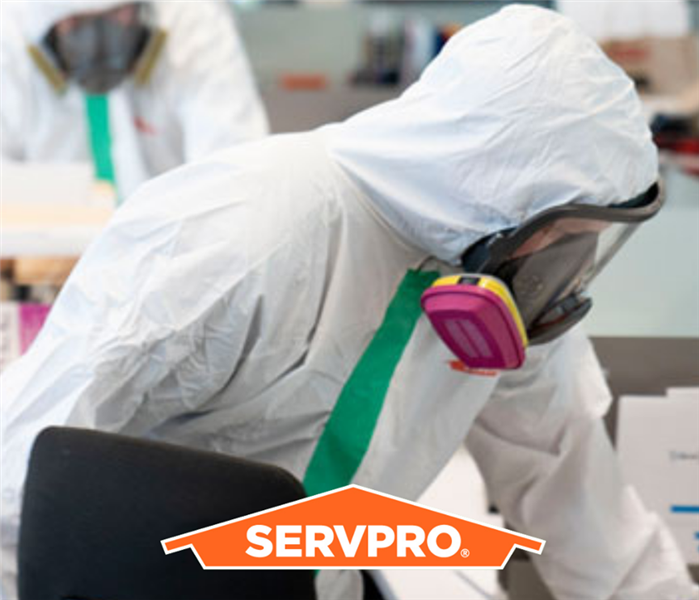 Our SERVPRO crew working on commercial cleaning.
Our SERVPRO crew working on commercial cleaning.
After a long first semester with the COVID-19 virus still lingering around and flu season is in full swing, it may be time to get your educational facility professionally cleaned. The perfect time to do this is over Christmas and summer break when there are no students to disrupt. A clean environment helps students to learn better and it also decreases the risk of students calling out sick from class.
When a school or other educational facility sustains water or other damage, it’s not only a loss of property; it’s also a loss of time spent learning, leaving many students struggling to catch up. SERVPRO® can help minimize your facility’s downtime so your staff and students can return safely. Whatever size facility you have, our trained technicians will work with your school’s administrators to assess water or other damage, regardless of the size or cause. Our professionals know how to restore the damage in areas specific to educational facilities such as classrooms, laboratories, and gymnasiums. It’s our goal to restore your school to its preloss condition with as little disruption as possible to students, teachers, and staff.
As the #1 choice in cleanup and restoration, SERVPRO is experienced in handling school water damage, fire, mold remediation, and the cleaning and disinfecting of facilities of all sizes, including:
- Early Childhood – Preschool and Nursery School
- Primary – Elementary and Middle Schools
- Secondary – High School and Academies
- Higher Education – College and University
- Industry Trade Schools
- Athletics – Gymnasium, Sports Complexes and Stadiums
COVID-19 in the Office: Applying 2020 Lessons in 2021
9/5/2021 (Permalink)
For the last year, it’s been hard to go an entire day without hearing or seeing the words: pandemic, Corona, COVID-19, 6 feet, social distancing, and everything related.
The COVID-19 pandemic was definitely the single most talked about topic in 2020 and for good reason as it has an effect in some way in everyone's life. Who could have thought that running back to your car to grab your mandatory face mask before going into a public place was going to be the new normal. With all of these changes and new rules and regulations there are new problems that have come to light.
Most businesses have been able to reopen and we have seen the “stay at home” orders become less and less in effect. With that being the case there is a whole new category of cleaning that needs to be done in order to ensure these businesses are safe for people to come to.
What questions to ask professionals responsible for disinfecting your space?
- Do your employees have a pathogen-specific certification for building disinfection?
- Are you properly insured to provide services (worker’s compensation, liability insurance, etc.) related to communicable diseases?
- Are you following a cleaning and disinfection protocol that is specific to that building?
- Are your employees in compliance with OSHA and EPA regulations? (i.e. training, infection control plans, PPE, proper chemicals, etc.)
- Do you have a properly written contract specific to COVID disinfection services?
Unfortunately, a lot of contractors hopping onto this new COVID cleaning bandwagon do not have the experience, certifications, and knowledge in order to ensure your business is up to the current OSHA and EPA standards, making these questions very important to ask before deciding on the company you will use for your business.
The solution to this new widespread problem we are seeing with COVID-19 is as simple as proper training. One training and certification possibility lies with The Pathogen Response and Resource Alliance (PR2A), which has established professional training and certification courses.
The Founders of PR2A provide unmatched and critical credibility that supports our overall mission in developing a nationally recognized COVID Standard of Care, starting with training and certification courses.
At SERVPRO we are committed to keeping with the highest standards in every service we provide. We offer Certified: SERVPRO Cleaned and all of our technicians are certified for pathogen-specific cleaning.
Give us a call today at 1-800-SERVPRO to see what we can do for your business.
How to Choose the Right Commercial Cleaning Company
9/5/2021 (Permalink)
There is nothing worse than turning off a potential new client because of a dirty or dusty-looking office space. When it comes to cleaning, businesses have two options, they hire individuals on their own payroll, or they just take the burden off their plate and hire a professional company to handle all those duties.
There are pros and cons to both options but overall hiring a professional cleaning company is usually the better option.
A commercial cleaning company understands every aspect of what it takes to both keep your office sparkling clean and the extent to which a very clean office makes a favorable impression on clients. They must do a great job of cleaning and maintaining your workplace, but you must also be confident that they will protect your business assets.
Top 5 Tips for Hiring the Right Company
- Find out their hiring and training requirements. A professional commercial cleaning services company will be able to discuss how they hire staff and evaluate employees. This process should include background checks and a formal training process. In addition, team members should be fully trained in safety and OSHA procedures.
- Ask for references. When selecting a commercial cleaning company, you should do a little research on their reputation. Check out their customer satisfaction reviews and the company’s overall standing within the local business community. Were other companies satisfied with their performance? Would they recommend them?
- Ask if they have liability insurance. All prospective commercial cleaning companies should be able to provide proof of insurance and demonstrate that they’re fully licensed. You should ask to see their general and workers' compensation certificates. It is also important they hire their own staff and not sub-contractors.
- Find out if they have an established cleaning process. You want to know if this is a well-established commercial cleaning company, with a history of serving businesses, a proven track record, and the ability to demonstrate they’ve achieved results for other clients.
- Choose a local company. Hiring a company with a local office or headquarters helps to ensure you will be able to have a crew out quickly if there is a need for them to do so.
If you run a business, making sure the floors are swept and the trash is taken out is probably not high on your list of priorities. Leave the dirty work to the professionals, as an uncleanly office can leave a negative impression.
SERVPRO has over 50 years of experience in offering this type of service and they understand the importance of a safe and clean environment at work.
Call 1.800.SERVPRO today to find out how they can help make sure your office stays sparkling clean.
Building an Emergency Plan for Your Workplace
4/5/2021 (Permalink)
 Have a plan in place for your employees' safety when disaster strikes.
Have a plan in place for your employees' safety when disaster strikes.
Disaster can strike anytime and anywhere. Mother Nature is unpredictable, and fires don’t stick to a convenient schedule. Emergencies at work are just as likely as emergencies at your own home. Creating a comprehensive emergency response plan can save lives.
The actions you take within the first few moments of any emergency are critical and can change the course of how the events unfold. Emergencies in the workplace can include Robberies. Cybersecurity Incidents, Natural Disasters, On-Site Accidents, etc. It is important to have a plan to battle any and all of the possibilities.
Steps to Creating an Effective Emergency Plan in the Workplace
Step one: Assemble the Team - The strength of the plan depends on the commitment of your team. Seek out the participation of everyone in the office in the early stages.
Step Two: Conduct Risk Assessment - Conduct a risk assessment to identify potential hazards and vulnerabilities within your organization. People should always be your first consideration in a risk assessment, but risks to physical assets and the environment should also be included in your assessment.
Step Three: Establish Objectives - Performance objectives are quantifiable and tangible milestones that you’ll achieve as you develop your emergency preparedness program. Key recommendations:
- Reach out to public emergency services and regulators.
- Conduct a business impact analysis (in addition to your risk assessment) to identify the operational and financial impacts from an interruption or disruption of your business.
- Identify opportunities for hazard prevention and risk mitigation.
- Protect the safety of your employees by developing evacuation, sheltering, and lockdown plans.
- Conduct employee training and drills.
- Install an emergency generator to power the data center during a power outage.
- Install a fire sprinkler system.
- Phase-out the use of highly toxic or flammable chemicals.
- Build a culture of preparedness in the workplace and encourage employees to have a plan at home.
Step Four: Create Written Policy - OSHA’s minimum requirements suggest that your plan should include the following elements:
- Means of reporting fires and other emergencies.
- Evacuation procedures and emergency escape route assignments.
- Procedures for employees who remain to operate critical plant operations before they evacuate.
- Accounting for all employees after an emergency evacuation has been completed.
- Rescue and medical duties for employees performing them.
- Names or job titles of persons who can be contacted in case of an emergency.
Step Five: Develop an on-site Emergency Response Team - Designate cool-headed and well-respected emergency response leaders within your organization to lead evacuation (as necessary), coordinate communication, conduct a headcount and communicate detailed information to 911 dispatch and emergency responders. These team members should also be responsible for making sure that minors, disabled employees, or at-risk residents are safely sheltered or evacuated.
Step Six: Practice and Review - Your Emergency Response Plan is only as good as the people who are carrying it out. Every six months, conduct emergency drills and schedule a one-on-one with your in-house ERT members to make sure they’re still up for the job.
Hopefully, this exercise will be done as a preventative measure and a just-in-case plan that will never need to be used. Unfortunately, Emergencies do happen, and in the case that they do, the first (or second) call you to make is extremely important. You should always call 9-1-1 first, but making your second call to SERVPRO can mean saving a lot of time and money restoring your office to its previous condition. Be sure to add 1-800-SERVPRO to your Emergency Response Plan, or reach out for help in creating one for your business.
Things to Look for When Buying a Commercial Building
3/1/2021 (Permalink)
 Know the tricks of the trade when it comes to purchasing your commercial property.
Know the tricks of the trade when it comes to purchasing your commercial property.
Looking for the perfect place to fulfill your lifelong dream of opening a bakery or a toy store? Looking for a new location to help your current business grow? No matter the reason, buying commercial property is a huge investment and should not be treated lightly. It is important to do your homework to ensure the purchase is the right one for you. Buying commercial real estate is a lot more challenging than purchasing a home and there are many things to be considered before pulling the trigger.
Location
When buying any property the location is a big factor, especially when it is a business. The infrastructure and surrounding neighborhood can either raise or lower the value of the property.
Some questions to consider:
- Are there any similar businesses located nearby?
- Will you have access to any support services like parking?
- What are the market trends for that area?
- What are the zoning laws where the building is located?
Knowing the answers to these questions and making sure they match your needs can save you from potential problems in the future.
Building Classifications
A commercial building is a property that’s used for business purposes. But there are different classifications for different types of property. For instance, office buildings are typically classified as Class A, Class B, or Class C. Class A buildings present the lowest level of risk, while Class C buildings come with the highest level of risk. Industrial buildings and retail stores have their own designations as well, so it’s important to understand how the property you’re considering buying is classified and what it means for you as a business owner.
Building Condition
The last thing you want to do is buy a property and then uncover a mold infestation that will cost you thousands of dollars to remediate. Avoid this by having the property thoroughly inspected before purchasing. Consider also what was the building previously used for and what kind of wear and tear has it been through over the years?
Team of Experts
There is a lot that goes into the purchase of a commercial building and having a team of experts in your corner can increase your odds of securing financing and spotting potential problems from the beginning.
Some of the experts that can help this process run as smoothly as possible:
- CPA
- Contractor
- Commercial real estate attorney
- Commercial realtor
- Mortgage broker
- Tax attorney
Financing Options
You’ll need to find the right financing options to purchase the building. The type of financing you’re able to secure will depend on your personal and business credit scores, the type of property you’re buying, and your lender. It is a good idea to get pre-approved before making an offer and your accountant can help.
Types of loans to consider for purchasing a commercial building:
- Conventional mortgage
- Bridge loan
- SBA 504 loan
- Hard money loan
Having all the information as well as a good team on your side will go a long way in making sure the property you choose to purchase will continue to be a dream come true instead of turning into a nightmare. Create a wish list of what is important to you and your business using these tips and that will give you a starting point to find the very best match for you.
What is an ERP (Emergency READY Profile)?
2/26/2021 (Permalink)
It is estimated that more than 50% of business owners are not prepared for an emergency or natural disaster. Whether it’s lack of insurance coverage, lack of planning, or inadequate savings, most businesses are one disaster away from going out of business.
That’s where a SERVPRO Emergency READY Profile comes in! SERVPRO offers this FREE service to business owners to help them prepare for disaster so they are ready to tackle the challenges that unexpected disasters can pose. An ERP contains the following:
- A thorough and free assessment of your place of business.
- A Profile Document that contains all necessary information needed in an emergency.
- A guide to help you get back up and running post disaster.
- Establishes your local SERVPRO franchise as your go to restoration and damage mitigation professional.
- Clear instructions on chain of command for work to commence post disaster.
- Detailed specific information regarding your facility management, like shut off valves, emergency exits, main frames, etc.
SERVPRO can help you and your business be “ready for anything that happens” and the first step is creating your ERP. With our 24/7 365 service and handy mobile app, you’ll be able to rest easy knowing you’ll be able to handle any emergency that comes your way.
How Often Should You Be Sanitizing Your Workplace?
2/5/2021 (Permalink)
 Regular sanitization of your business can make a difference in the health of your employees and clients.
Regular sanitization of your business can make a difference in the health of your employees and clients.
Pandemic or not, cleanliness and sanitation are important in the home and workplace. When the world was turned upside down (or so it seemed) because of COVID-19, we began to see new standards for health and safety. One obvious precaution that was taken (almost immediately) was cleaning and disinfecting an area that was exposed to a positive COVID-19 case. But what about the “normal” or “day-to-day” cleaning? How often should you be sanitizing your office?
The amount of cleaning that should be done usually depends on the amount of traffic and the kind of work that is being conducted in your workplace. Obviously, if there are a lot of people in and out of the building, touching surfaces, and sharing workspace, then some sort of daily cleaning and disinfecting should be conducted. Sometimes this may look like a cleaning crew coming in at the end of the day and taking care of everything. Or perhaps, they come in and clean, but sanitization takes place during the day and is the responsibility of those using the space (cleaning wipes and spray at each station).
Maintaining a clean and safe workspace by cleaning and sanitizing regularly can easily be done and make a world of a difference. Begin by evaluating your space and the resources available, once you have done this you can come up with a plan then implement it into the office routine. By doing this, it will be easier to ensure a healthy work environment for employees and customers.
Maintaining Air Quality in Your Northern Summit County Business
2/5/2021 (Permalink)
 Keep fresh air flowing for you and your employees.
Keep fresh air flowing for you and your employees.
CLEAN air is a vital part of staying healthy, more so during the winter when we tend to want to curl up and shut our windows tightly.
But stale indoor air being continually recycled around your home or office is not good news – especially for those with allergies or respiratory problems as this cycle simply increases the number of spores, pet dander, and dust moving around your property.
Luckily improving air quality is simple and straightforward by some good habits.
Number one – keep your space clean. Regular vacuuming, especially with a model containing a HEPA filter, will literally suck away much of the dust or pet dander. Hardwood floors also make it harder for allergens to accumulate. The same thinking applies to regularly clean curtains and drapes, and laundering bed linens – preferably at a higher temperature.
Next, check and change your filters. It is easy to overlook but if they are doing their job, they will get dirty and clogged up over time, and this is especially true with forced-air heating systems.
It may also worth getting your ducting cleaned regularly to remove any trapped dust – but this does depend on your system and is not always appropriate, so seek advice.
Air purifiers are a good investment, especially for those with respiratory problems, and are essential if you cannot remove the cause of the allergens – after all, our pets are part of our family. These may not eliminate allergens but can cut them down significantly.
And a dehumidifier in damper areas such as the basement can help reduce mold growth and the spores mold emits.
Finally – fresh air is your friend. Even in the coldest months, open your windows occasionally and let clean air into your home.
Flat Roof Maintenance to Prevent Disaster at Your Northern Summit County Business
1/4/2021 (Permalink)
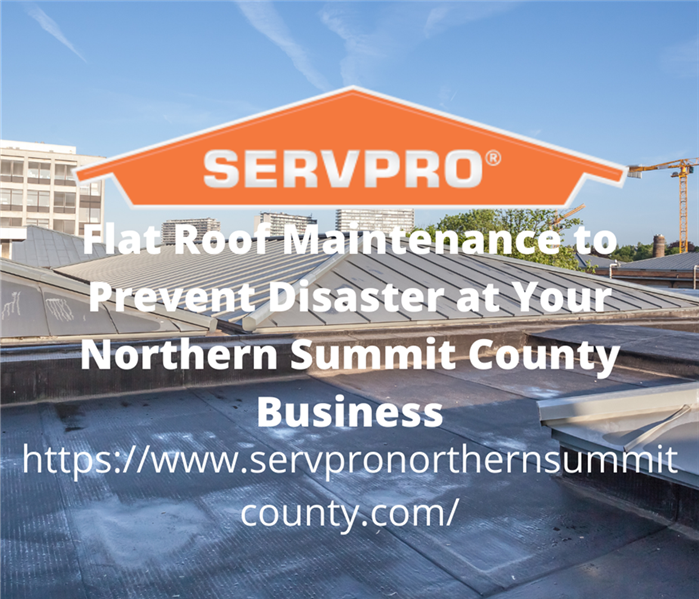 Maintain proper care of your building's flat roof.
Maintain proper care of your building's flat roof.
Many commercial buildings have a flat style roof. If you’re the owner of a commercial building, it’s likely you’re already aware of the required regular maintenance for flat roofs as regular maintenance is important in preventing catastrophic damage in the event of extreme weather.
Flat roof maintenance can seem overwhelming and sometimes costly, but the maintenance costs pale in comparison to the costs that can be incurred by damage to a poorly maintained flat roof. Here are 5 tips for keeping your flat roof in tip-top shape:
- Regular Inspection
Wear and tear on a flat roof is not always immediately apparent. Make sure to hire a licensed professional to perform an annual inspection on your roof.
- Trim Surrounding Foliage
If you have large trees near your building, it’s a good idea to maintain the branches and trim any foliage that extends over or nearby your roof. Storms can cause nearby branches to break which can ultimately damage your roof as a result.
- Install and Maintain Proper Drainage
Pooling water is often the culprit of roof damage and deterioration. Proper drainage is extremely important for buildings with flat roofs. Make sure you are regularly checking for clogs and leaks within your drainage system.
- Clean All Debris
Collecting debris can not only cause issues with your roof’s integrity but can also mask other areas of concern. Be sure to clean debris off of your roof on a regular schedule.
- Do Not Store Anything on Your Roof
Your flat roof is susceptible to stress and caving if it is used improperly for storage. Flat roofs are not typically built to carry any weight beyond what is predetermined at the time of construction.
By following these simple steps, it’s likely you’ll get the most life out of your flat roof. However, even the best-laid plans fall short and disasters can happen to anyone. SERVPRO’s team of trained professionals is faster to any disaster and specializes in commercial restoration. Remember your SERVPRO partners if you are ever in need of commercial roof repair.
Your Business Needs a Contigency Plan
9/30/2020 (Permalink)
 Make sure that you know what to do if your business faces a disaster.
Make sure that you know what to do if your business faces a disaster.
WHEN disaster strikes, it can often deal a fatal blow to a business – but those that survive often do so because they have a plan in place.
And a good contingency plan is well worth taking the time and effort to prepare so when the worst happens everyone knows exactly what to do, how to do it, and when to do it.
People buy home insurance not because they expect their house to burn down – but just in case it does.
The same is true for contingency planning – taking the time to work out how you will keep operational when faced with the sudden loss of access to your building is simply essential.
For example, can staff work from home? Have you the ability to reroute suppliers? Can you switch to an alternative location? Is your information technology infrastructure backed up remotely? How do you communicate with your customers?
And all the while you are picking up and carrying on with the day-to-day of your business, what plans are in place to repair and restore the damaged facilities?
SERVPRO of Northern Summit County can be an ideal partner in your contingency planning – by talking with us when there is nothing going wrong means our experts can be fully prepared and ready to step in the very moment something does go wrong.
Our teams are experts in cleaning up post-disaster and repairing and restoring your facilities to full operational capacity quickly – and we can do this to maximum effect if we know before it all goes wrong. Call us today for help in putting together your contingency and continuation plans.
Why You Need a Restoration Specialist and Contractor on the Same Team
9/25/2020 (Permalink)
 Trust a company that can do it all for you and return things to normal for you faster.
Trust a company that can do it all for you and return things to normal for you faster.
WHEN you find yourself needing restoration and cleanup services after a disaster, it is often only stage one of the complete job.
Returning your home or business to the way you need it after a flood or fire or storm is many times going to require renovations and repairs which cannot even be properly assessed until after the debris is cleared up. That’s where SERVPRO of Northern Summit County is ideally positioned to help.
We do not just pack up our equipment and disappear once we have cleaned up as many firms do – we are on hand to help through the entire restoration process.
Our expertise in handling the immediate aftermath of a disaster means we can feed vital information and knowledge into the restoration teams that follow behind our initial work.
As a complete one-stop solution we are uniquely positioned to handle the repairs after the cleanup operation is complete.
And as you are dealing with the same people throughout the whole process you have a clear and direct channel of communication, avoiding having to act as a liaison between different firms and contractors trying to get your home or business up and running as you need it again.
Project technicians can assess the situation on hand during the early cleanup phase and keep the construction staff informed of what is needed. This allows our construction experts to be estimating budgets, planning for materials, obtaining permits, and organizing team coverage. All this is done to avoid causing you time, trouble, and effort coordinating multiple contractors during an already stressful time.
SERVPRO of Northern Summit County is on hand 24 hours a day, 365 days a year, ready to help you get back to normal as quickly and safely as possible.
Restoring Your Commercial Property After a Fire
9/17/2020 (Permalink)
 If fire happens at your property, you'll need a professional team to return things to normal quickly.
If fire happens at your property, you'll need a professional team to return things to normal quickly.
FIRE is the biggest destroyer of businesses by far – most businesses that suffer a large fire simply never reopen their doors again.
Naturally all businesses are going to be impacted by a disaster of any kind – a tornado or flooding for example.
But in most cases, with proper clean up and repairs, a business can soon be back on its feet and welcoming customers once again.
Fire is different – the heat and smoke damage from a fire can literally destroy even the strongest of structures, rendering even brick-and-mortar buildings dangerous and unsafe.
Which is why it is vital to call experts in as soon as possible if you want to see your business trade another day.
Starting with a 24-hour response, SERVPRO is there to begin work immediately to get you back to work with the minimum of interruption possible.
Our experts will immediately assess the damage, begin work to mitigate further damage if necessary, and start planning for the clean up.
This involves not just working on smoke and fire damage, but removing the water and foam that will have been used by the fire service to extinguish the blaze.
And finally our team will work with you to restore your commercial premises back to a fully functioning business environment as quickly and efficiently as possible – better than new.
Is Your Business Ready For Storm Season in Northern Summit County?
4/3/2020 (Permalink)
 SERVPRO of Northern Summit County has the expertise and the resources to handle your business water damage.
SERVPRO of Northern Summit County has the expertise and the resources to handle your business water damage.
Did you know that 50% of businesses never reopen after a fire, storm, or water disaster? SERVPRO of Northern Summit County is available 24 hours a day to get YOUR business back up and running, "Like it never even happened."
Lightning strikes account for 6.5% of property claims. High winds, heavy rain, and flooding from a thunderstorm can destroy a business in minutes. If your business is not prepared for a quick recovery, the lost revenue of your business could mean closure.
SERVPRO has over 40 years of experience as a leading fire and water cleanup and restoration provider. There are over 1,500 franchises servicing 48 states, which allows more locations for faster responses.
We are quick to respond because we help ensure the damage is contained and the restoration process begins promptly. We help with large loss capabilities; no fire or water damage is too big.
Help prepare your business disaster by signing up for our Emergency Ready Program. This will reduce business interruption following a disaster, call for details.
SERVPRO of Northern Summit County has the expertise and the resources to handle your business water damage. If you need assistance call (330) 650-4486. We are open 7 days a week, 365 days a year including all major holidays.
Call SERVPRO of Northern Summit County When You Are Have Damage at Your Business
3/2/2020 (Permalink)
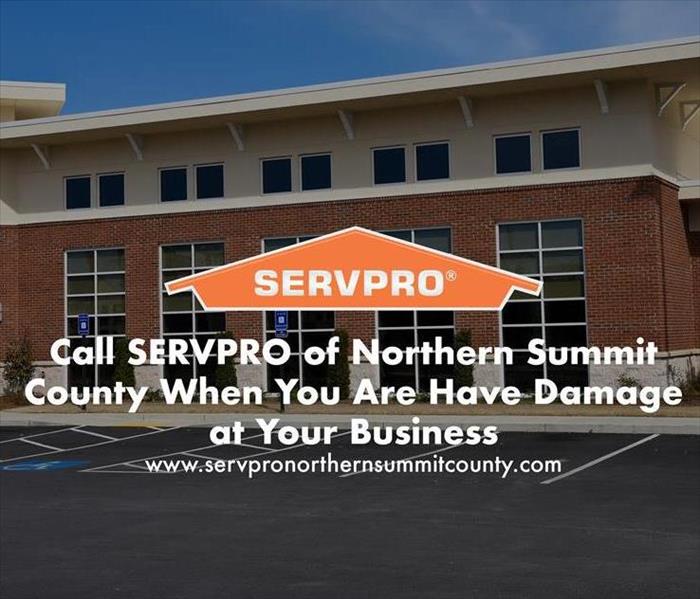 SERVPRO of Northern Summit County has the expertise and the resources to handle your business water damage.
SERVPRO of Northern Summit County has the expertise and the resources to handle your business water damage.
Damage to your business can happen at anytime, especially when there is flooding or high water. Business owners need a reputable and reliable company for when these crises become realities.
Slow water leaks can come out of no where in your business, which can damage products, office furniture, and the structure of your building. SERVPRO of Northern Summit County specializes in restoring water damage to your structure.
Water can quietly seeps in from cracks that is in plumbing or improperly installed gutter and drain systems. We train our technicians to discover the source of the water and to restore the damage done.
We use high-efficiency air movers, heaters, and dehumidifiers to remove water as vapor from your building; this helps ensure that we prevent any mold damage. We focus on restoration to your business building, to make it look “Like it never even happened.”
We work quickly to inventory and move wet products to a dry staging area. SERVPRO of Northern Summit County is in constant communication with your insurance provider so that you can develop the evidence for any claims needed. Your business will be restored in no time.
SERVPRO of Northern Summit County has the expertise and the resources to handle your business water damage. If you need assistance call (330) 650-4486. We are open 7 days a week, 365 days a year including all major holidays.
Fire Prevention Safety Tips for Your Business
2/4/2020 (Permalink)
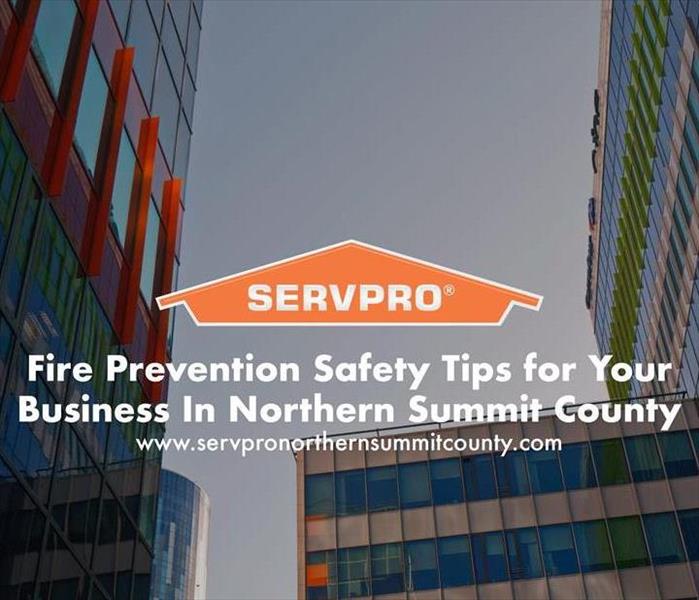 SERVPRO of Northern Summit County has the expertise and the resources to handle your business fire disaster.
SERVPRO of Northern Summit County has the expertise and the resources to handle your business fire disaster.
Fires can happen at anytime in businesses. There are some quick tips for business owners to follow so that they can prevent a fire, or prevent it from spreading quickly:
- Extension cords are a common electrical violation. Extension cords attached to building surfaces as permanent wiring or extended through walls, ceilings, floors and under rugs. Extension cords should only be used on a temporary basis and must be properly rated for the intended use.
- Both smoke and CO detectors have saved thousands of lives over the years. Smoke detectors should be located on the ceiling of each floor or on a wall; this should not be more than four inches from the ceiling.
- Fire extinguishers can help in the early stages of a fire if you are in a safe location and know what to do.
- All fire extinguishers are tested by the Underwriters Laboratory (UL) for safety and performance. They are rated based on the type of fire they will put out, and their classification is determined by the size of the fire they will put out.
Make sure to always call 9-1-1 if you are experiencing a fire and take safety first and foremost before taking precautions into your own hands.
SERVPRO of Northern Summit County has the expertise and the resources to handle your business fire disaster. If you need assistance call (330) 650-4486
Prepare Your Business For Fire Before It Happens In Northern Summit County.
1/1/2020 (Permalink)
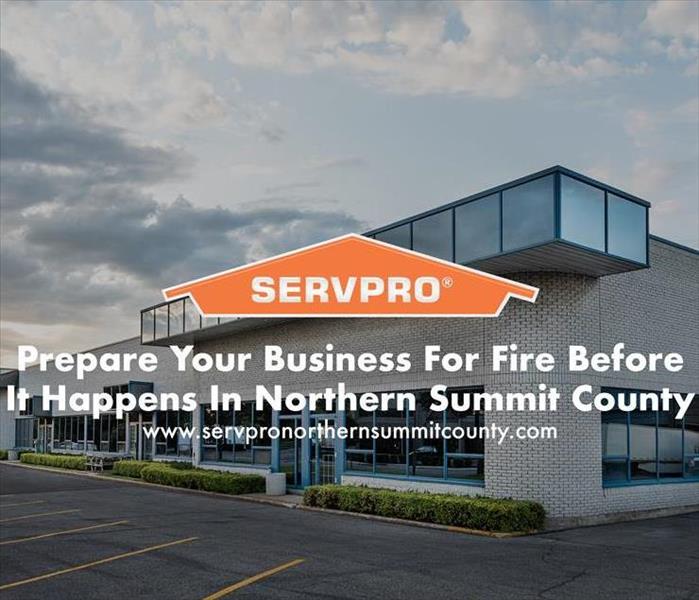 SERVPRO of Northern Summit County has the expertise and the resources to handle your business fire disaster.
SERVPRO of Northern Summit County has the expertise and the resources to handle your business fire disaster.
Commercial Fire Damage Restoration is something that no business owner wants to go through. However, the truth is it might happen. The best advice to prepare your business for a fire before it happens is to make sure that you have some sort of Emergency Plan in place.
It is best to hire SERVPRO of Northern Summit County, even before the fire hits your business. We can help you develop an Emergency Readiness Plan for your employees so that when disaster hits you are prepared as best as can be.
Fire damage is especially devastating for a business or commercial property, since you will not be operate normal hours for a little while. In addition to the fire and smoke damage, significant water damage from firefighting efforts and fire suppression systems may occur.
Every hour spent restoring your business back to pre-fire condition is an hour of lost revenue and productivity; we know how critical this is as a business owner. If your business experiences a fire loss, call the fire and water damage restoration experts and we’ll respond immediately to get you back to business in Northern Summit County.
SERVPRO of Northern Summit County has many benefits:
- 24 Hour Emergency Service
- Faster to Any Size Disaster
- A Trusted Leader in the Fire and Water Restoration Industry with over 1,700 Franchises
- Highly Trained Fire and Water Damage Restoration Specialists
SERVPRO of Northern Summit County has the expertise and the resources to handle your business fire disaster. If you need assistance call (330) 650-4486
Ready Plan For Your Business in Northern Summit County
12/4/2019 (Permalink)
 SERVPRO Emergency READY Profile minimizes businesses interruption by having an immediate plan of action
SERVPRO Emergency READY Profile minimizes businesses interruption by having an immediate plan of action
As many as 50% of businesses close down following a disaster. The businesses that survive, the overwhelming majority of them had a preparedness plan in place. Pre-planning can be q peace of mind, and knowing you are "ready for whatever happens”.
SERVPRO Emergency READY Profile minimizes businesses interruption by having an immediate plan of action simply because your team will know what to do and what to expect in advance if damage strikes.
Here are some SERVPRO Emergency READY Profile facts:
- It is a no cost assessment of your facility. This means there is no need to allocate funds.
- You will have a Profile Document that contains only the critical information needed in the event of an emergency.
- This is a guide to help you get back into your building following a disaster and can help minimize the amount of time your business is inactive.
- Establishes your local SERVPRO Franchise Professional as your disaster mitigation and restoration provider.
- It provides facility details such as shut-off valve locations, priority areas and priority contact information.
Having a quick reference of what to do, how to do it and who to call provides solutions in advance of an emergency so that during your business emergency you are "Ready for whatever happens."
SERVPRO of Northern Summit County has the expertise and the resources to handle any size disaster. If you need assistance with storm or flooding call (330) 650-4486
Commercial Evaluating Mold: Air Sample Testing
10/2/2019 (Permalink)
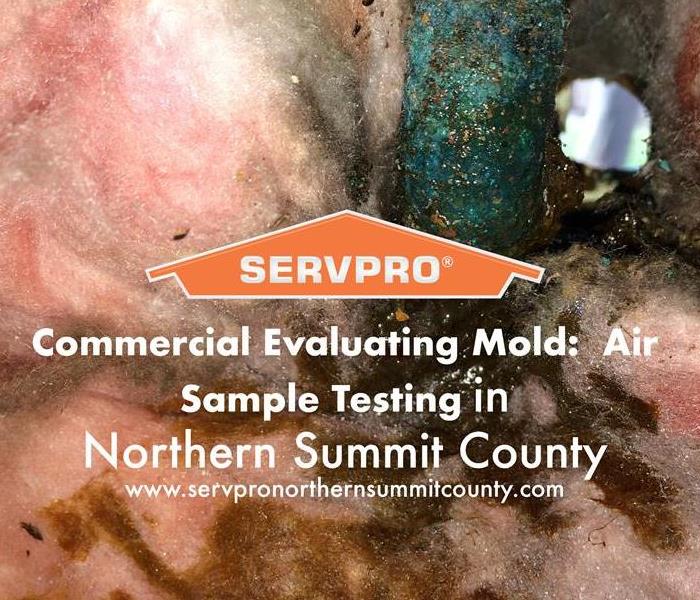 Our mold process is efficient so that you can get your business back on track in a timely manner.
Our mold process is efficient so that you can get your business back on track in a timely manner.
All commercial buildings contain mold spores since they a natural part of the environment. An elevated mold count especially one that contains spores from varieties of mold that are commonly found when water damage is involved, such as stachybotrys chartarum, can indicate that there may be a structural moisture problem.
In the insurance claim process, mold testing is generally utilized after the mold has been remediated to confirm that the mold spore count is at or below the count found outside the building. The test is conducted while the remediated area is contained in order to confirm the success of the cleaning process.
Determination of airborne spore counts is accomplished by way of an air sample, in which a specialized pump with a known flow rate is operated for a known period of time. Conducive to scientific methodology, air samples should be drawn from the affected area, a control area, and the exterior.
The air sampler pump draws in air and deposits microscopic airborne particles on a culture medium. The medium is cultured in a laboratory and the fungal genus and species are determined by visual microscopic observation. Laboratory results also quantify fungal growth by way of a spore count for comparison among samples. The pump operation time was recorded and when multiplied by the operation time results in a specific volume of air obtained. Although a small volume of air is actually analyzed, common laboratory reporting techniques extrapolate the spore count data to equate the amount of spores that would be present in a cubic meter of air.
Our mold process is efficient so that you can get your business back on track in a timely manner. We are happy to serve commercial buildings with mold damage in the SERVPRO of Northern Summit County.
If you have questions or need further information about the mold testing process, contact SERVPRO of Northern Summit County at 800-648-1212.
Does your commercial building need Ordinance Or Law Coverage? YES IT DOES!
10/1/2019 (Permalink)
 How much ordinance or law coverage to you need? There is no way to get an exact number but you should look at the worst case scenario.
How much ordinance or law coverage to you need? There is no way to get an exact number but you should look at the worst case scenario.
Commercial structures built more than a few years ago are most likely deficient in some aspect of the applicable building code. Building codes change rapidly and in large insurance losses, having too little or no Ordinance or Law coverage can potentially cost you a substantial amount of out of pocket expense. Ordinance or Law provides three critical areas of coverage: Coverage for Loss to the Undamaged Portion of the Building, Demolition Cost and Increased Cost of Construction Coverage. Many reconstruction projects frequently uncover code issues and without Ordinance me, the building owner is responsible for the additional cost. According to Adjusters International Disaster Recovery Consulting, compliance with ordinances and laws after a loss can add 50% or more to the cost of the claim. A tough pill to swallow if your business has to pick up the expense!
How much ordinance or law coverage to you need? There is no way to get an exact number but you should look at the worst case scenario. For Coverage A, Loss to the Undamaged Portion of a Building, experts suggest choosing the total limit scheduled in your property policy. For Coverage B, Demolition Costs, a rule of thumb is $5 per square foot. Coverage C is for the Increased Cost of Construction and one suggested method for determining coverage uses cost averaging. Experts suggest multiplying .5-1% of the building value by the age of the building to come up the amount of insurance coverage required. For example at 1%, a ten year old $500,000 building would need $50,000 in coverage (1% X 500,000=$5000 X 10 Years= $50,000). You can also ask your insurance agent about blanket coverage.
Don’t be caught short on funds to get back in business after a disaster. Be sure to review your Ordinance or Law coverage with your commercial insurance agent and seek advice regarding the recommended amount of insurance coverage. If a disaster strikes your business, the trained staff at SERVPRO of Northern Summit County are commercial restoration experts and are here to help. Call 800-648-1212 for assistance 24/7.
Your Commercial Building had a Sewage Back Up… Now What?
9/4/2019 (Permalink)
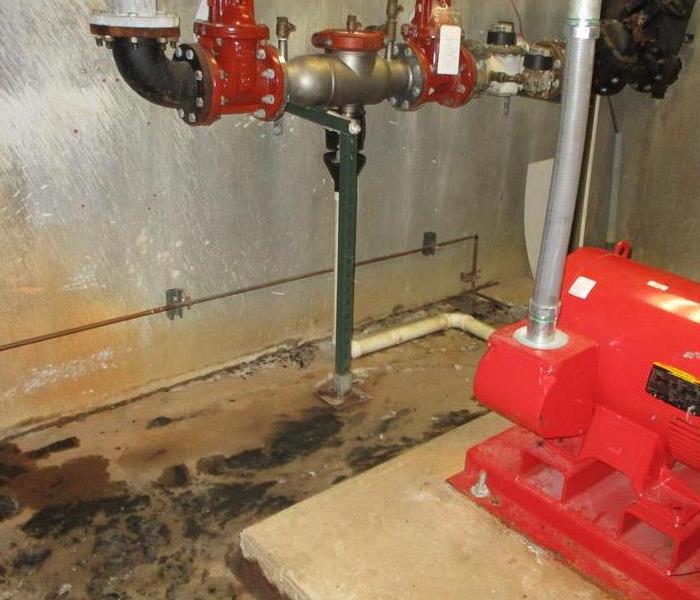 The goal is to return your property to sanitary conditions quickly and efficiently when mitigating sewage contaminated environments.
The goal is to return your property to sanitary conditions quickly and efficiently when mitigating sewage contaminated environments.
Removing sewage and restoring your building back to a level of acceptable cleanliness is more difficult than it sounds. Mop it up and throw some bleach at it, right? If only it were that easy. In order to achieve a healthy and safe environment for your employees, tenants and customers, a three-step cleaning process in conjunction with appropriate drying procedure is critical. Professional mitigation companies such as SERVPRO of Northern Summit County follow a strict protocol based on the IICRC S500 Standard Reference Guide for Professional Water Damage Restoration.
The goal is to return your property to sanitary conditions quickly and efficiently when remediating fecally-contaminated environments. Contaminants can be spread by tracking and aerosolization so proper containment and PPE should be utilized. Due to this fact, decontamination is performed first before drying fans are placed. This involves rough cleaning, initial sanitizing and demolition. Porous materials are removed and discarded at this stage and if the sewage has penetrated below non-porous flooring, it has to be removed as well. Detailed cleaning follows which involves not only using appropriate disinfecting but also the use of hot water which penetrates irregular surfaces and semi-porous material. Multiple rounds of cleaning may be required. During the cleaning stage dehumidification should be used to help prevent mold growth and once the building is sanitized properly, fans are placed to dry the environment.
All steps outlined above are critical for returning your building back to a healthy and safe place for your employees, tenants and customers. If you have questions about this process or need assistance with a sewage clean-up, SERVPRO of Northern Summit County is at your service 24/7 by calling 800-648-1212.
Back to Basics: 6 Steps to Handle Large-Loss Fire Restoration
4/2/2019 (Permalink)
Not only can a fire be devastating for the structure of a home or building, but it can also be emotionally devastating when it comes to the occupants of that structure, whether that is a family of four or a company of 400 workers. That's part of the reason why handling a large-loss fire doesn't just involve restoring the property to a preloss condition, but also being sensitive and understanding with the occupants of the affected home or business. That's not to say that restoration professionals are counselors — they're not — but acting with empathy can go a long way toward making a fire loss a little less stressful for the individuals who are most impacted. Here are six steps to follow to handle large-loss fires:
- Getting the call: Whether this initial call comes from a homeowner or the insurance company, this first point of contact is an ideal time to gather as much information as possible about the fire. Where did it occur? How many rooms are affected? What type of fire was it? The goal of this initial point of contact is to gather information to get an idea of the scope of the project before arriving on site.
- Arrive on site/inspection: After the initial phone call comes an on-site inspection. This is typically done after the fire department has doused the flames and secured the property. By this point, the restoration team should have a good idea of what type of fire occurred (i.e. protein fire, petroleum fire, etc.) and inspecting the property helps team members estimate the scope of work that will be involved, the timeline of the project and whether or not any demolition and reconstruction will be necessary. Depending on the severity of the fire, the restoration team may also board up the windows and doors to ensure structural stability.
- Access occupant needs/packout: If it is possible, restoration professionals will likely ask the building occupants to gather any immediate needs. For a house fire, this may consist of undamaged clothes, school supplies, computers, etc. Everything else in the facility that has been affected by the fire will then likely be packed out and taken to an off-site location for contents restoration.
- Estimate and begin work: After estimating the cost of the project and having the proper documents signed by all parties involved, then work can start on the fire loss. For a large fire loss, demolition and reconstruction of at least a portion of the property is likely necessary. Other areas of the property may just require soot and smoke damage restoration, where walls are HEPA (high-efficiency particulate air) vacuumed and washed, items are hand-cleaned and carpets are deep cleaned to remove soot residue. While restoration is occurring on site, it's also likely occurring off site in terms of the packed out contents (i.e. affected clothes, electronics, hard items, soft goods, etc.).
- Frequent communication: Whether the project takes five days or five weeks, good restoration contractors will be in regular communication with both the insurance company and the homeowner or business owner. This constant communication helps keep all parties up to date on progress, as well as provides an outlet for questions to be asked and answered related to the project. Communication is often the differentiating factor between good and poor restoration contractors, as keeping in regular touch with relevant parties ensures transparency and provides a regular source of contact.
- Final jobs/walk-through: After the crux of the project is complete, the last step is usually having the air ducts professionally cleaned and deodorized so soot doesn't contaminate — or cross contaminate — the facility. Following this, the occupant and insurance adjuster will likely take a final walk-through of the property to ensure the job has been done adequately and correctly. Any contents that went off site for cleaning will also be returned to the home and placed in their original location.
As you can see, a large-loss fire restoration job is a bit of a different challenge compared to a standard water damage restoration or mold remediation job. It's important your crew is trained to properly handle all the steps of every unique job.
Advanced Planning Ensures Experienced Partner Before Disaster Strikes
4/2/2019 (Permalink)
Thousands of commercial and industrial buildings each year are damaged by unforeseen disaster, ranging from fire or smoke and soot to water that infiltrates walls, floors, and equipment through events such as a burst water pipe, seepage, fire sprinkler flooding or leaks from a rainstorm.
Thousands of commercial and industrial buildings each year are damaged by unforeseen disaster, ranging from fire or smoke and soot to water that infiltrates walls, floors, and equipment through events such as a burst water pipe, seepage, fire sprinkler flooding or leaks from a rainstorm.
Wherever such an event occurs, the results can be operationally and financially disastrous. Potential risks include destruction of interior structural materials, equipment and files; disruption of operations; further damage from humidity; and, if water is not abated quickly, microbial damage -- the growth of mold, which is a potential health hazard.
When damage occurs, it is essential to take immediate action to stabilize the loss and mitigate damage. Doing so will maximize recovery of all contents such as inventory, machinery, furniture, carpeting, electronic media, documents and files, will minimize replacement costs, preserve good indoor air quality, and control mold risks.
Advance Planning
The best “insurance” in a recovery situation is to plan in advance of an occurrence by creating a Disaster Recovery Plan (DRP). The DRP defines and prioritizes the recovery and restoration of areas within a facility and details immediate next steps. It also designates the professional disaster restoration services provider to be summoned immediately when an incident occurs.
Pre-selecting a full service restoration provider that provides priority emergency services assures that building owners and managers will have a “partner” in the reclamation process. There will be no learning curve during an emergency because the firm already will be familiar with the structure and the plan. It then can move rapidly to begin recovery work within the first 24 hours – a critical parameter to minimize the effects of water.
Select a restoration provider that offers guaranteed priority emergency services. In the event of a fire, weather related or other water-damage disaster to a building or facility, owners or managers of properties registered in these programs will receive immediate priority for emergency drying and restoration services.
Expectations
Following is a list of services you should expect of the restoration company you contract:
- Consulting. The project scope should be provided at the front end. The firm quantifies the damage, determines what can be saved, recommends the equipment and process and expected results.
- Project Management. The company has the ability to quickly assemble a cohesive work team, provide rapid emergency response time, provide a turnkey operation for recovery and restoration and guaranteed results.
- Stabilization: The provider takes the necessary steps to stabilize the environment and assists with relocation efforts to an unaffected area or off-site, if necessary.
- Dehumidification and Drying. Through removal of standing water and excess moisture, the firm has the ability to reduce material loss, limit indoor air quality problems and speed return to occupancy and operation of the affected business.
- Cleaning and Disinfecting. By cleaning, sanitizing and disinfecting interior surfaces, the provider eliminates contamination from molds, bacteria, mildew and potential biological hazards.
- Odor Control: Thermo fog, wet spray, ozone or dry vapor methods should be properly employed to control odor.
- Electronic Equipment Restoration. In many cases, it is possible to clean and restore hi-tech components following exposure to fire or water damage.
- Preservation of Large-Scale Production Equipment. Contamination removal preserves production-operating equipment.
- Document and Media Restoration. Cleaning, sanitizing, deodorizing and drying restores paper records and electronic and digital media storage. This process is most effective if the firm dry cleans by vacuum and has refrigerated transport storage capabilities to minimize deterioration of materials.
- HVAC and Mechanical Systems Cleaning. Cleaning and deodorizing the supply and return duct system as well as the metal housing that encloses coils, heat exchangers and filter banks assures that clean air again passes through the system into the structure.
- Smoke and Water Decontamination. Residue from damage sources such as fire, flood and storms is removed.
- Corrosion Control. Metal surfaces are cleaned and treated to prevent further damage from corrosion.
- Controlled Demolition and Disposal. Surfaces that will not respond to restoration efforts in a cost-effective way are removed to expose hidden cavities and to expedite the recovery process or to remove sources of odor.
Selecting the Right Firm
It is important to have properly trained cleaning and restoration technicians overseeing your recovery project. A list of providers can be obtained from organizations like the Property Loss Research Bureau (PLRB). You also may want to do the obvious: review Web sites; read the case histories on the site; contact company representatives.
While it may sound as a cliché, the assessment process begins with reviewing experience, reputation and references. Plan to do more in-depth research before making a commitment.
Ordinance or Law Coverage- Every Building Should Have Coverage
2/19/2019 (Permalink)
Ordinance or Law Coverage- Every Building Should Have Coverage
Ordinance Or Law Coverage allows for payment of losses arising out of the enforcement of building laws or ordinances, including those that may require the demolition of damaged structures that increase the cost of repairing or rebuilding the damaged property. According to Adjusters International Disaster Recovery Consulting, compliance with ordinances and laws after a loss can add 50% or more to the cost of the claim.
Building codes or ordinances set minimum standards that must be met when structures are built or reconstructed. Their purpose is to protect the health and safety of building occupants. Building codes may be enacted and enforced by state and/or local governments. Building codes are primarily directed at new construction. Yet, they may also apply when existing structures are renovated, altered, reconstructed or used in a different way.
Some codes may require a building that is only partially damaged to be demolished and reconstructed rather than repaired. A building may require demolition and reconstruction if the damaged portion is worth 50% or more of the building's value. Codes can affect the size, design, height, usage and location of a structure. They may also determine the building materials that may be used.
Building codes change frequently. Codes that existed when a structure was built may be outdated when a loss occurs. To meet current codes, a damaged building undergoing repair may require expensive materials. Some structures may need to be reconfigured. Thus, building codes can significantly increase the cost of the repairs or renovations.
Homeowners policies often include a standard amount of ordinance or law coverage which is 10% of the dwelling coverage or coverage A. This may be enough for newer or updated homes but careful review of possible building code issues should be made in order to determine if more coverage makes sense. In commercial insurance, ordinance or law coverage is not typically included and can be added with an endorsement. It is important to take a comprehensive look at the building and potential ordinance or law costs that may be incurred in order to determine how much coverage should be added.
Consult your insurance agent for more information so you won’t get burned if you have a disaster.
How small businesses can better protect themselves
10/3/2018 (Permalink)
Even the best-run small businesses face the risk that external factors beyond their control, like a natural disaster, could derail operations.
A recent joint survey conducted by Insureon and Manta revealed that approximately 60% of small business owners don’t have either a formal disaster recovery plan or business interruption insurance, both of which could help them bounce back if an unforeseen event like Hurricane Florence forces their business to temporarily close.
Natural disasters are unpredictable such as the recent wildfires in California are unpredictable. Out-of-control fires in Yosemite threatened the livelihood of small business owners in the hospitality industry, with one innkeeper estimating a loss of at least $20,000. Other local businesses, such as guided tour and day trip operators, faced the possibility of serious financial losses and the need to dip into savings to cover operating expenses.
While a disaster recovery plan won’t completely insulate small businesses from problems caused by Mother Nature, a well-thought-out strategy can help minimize the impact. In addition to purchasing commercial property insurance to help pay for repairs to damaged property, business owners should also consider buying a business interruption insurance policy. Not only can it help expedite recovery from a disaster, it can also minimize a business’ financial losses.
Developing a comprehensive disaster recovery plan
In the event of a natural disaster, small businesses may be forced to temporarily close. Unfortunately, not all businesses are equipped to survive a prolonged shutdown. According to the survey, 31 percent of owners don’t know if their companies would be able to resume operations if they had to close for longer than one month, with an additional 13 percent confident that they would definitely not be able to reopen. However, only 39 percent of small business owners surveyed said they have a formal disaster recovery plan in place.
Disaster recovery plans can help business owners act fast to protect their company’s infrastructure and get the business back up and running as quickly as possible. Some information to consider including in a recovery plan includes:
- A list of key contacts, such as the insurance company, utility companies, suppliers and financial institutions
- A detailed plan of what steps employees should take in the event of an emergency
- A communication plan for notifying customers and vendors of the closure
- Documents and resources that are critical to the business’ operations
To keep everyone in the loop, employers may want to review disaster recovery plans with employees during on-boarding, and hold annual emergency response drills.
Why add business interruption insurance?
Companies face more than just physical damage from natural disasters; they also experience financial losses from being forced to halt operations for a period of time.
While property insurance can pay to repair building damage caused by a wildfire, business interruption insurance covers the potential income lost during a temporary closure. These payout amounts are usually based on income and expense records, so business owners should carefully store copies of these documents in a safe, off-site location.
Business interruption insurance can vary from policy to policy, but typically provides coverage for the following three things:
- Profits an owner would have earned if the business was not forced to close
- Normal operating expenses, including employee wages, taxes and loan payments
- Temporary relocation expenses, such as moving and rent costs
Business interruption insurance usually will not cover costs related to utilities, income that isn’t properly documented and losses caused by a partial closure.
Some policies might not protect against every natural disaster. For example, if events like wildfires are not covered by a proprietor’s property insurance policy, their business interruption policy won’t cover expenses related to wildfires either. For total protection, proprietors should verify with their insurance carriers that their policies cover common natural events that are specific to their geographical vicinity.
Above all, small businesses can best prepare by taking a proactive approach to disaster recovery planning. In the absence of a plan or adequate insurance, small business owners are putting themselves at risk for significant financial losses that could force some to permanently close. With the right combination of preparedness and comprehensive insurance, business owners can ensure they are ready for anything Mother Nature throws their way.
Disaster recovery for agents, brokers & claims professionals
10/3/2018 (Permalink)
A hurricane is coming. You’ve implemented your business’s emergency preparedness plan. You’ve boarded up your brick-and-mortar location in the storm’s path. You’ve ensured your staff’s safety. You’ve secured your CRM data at an offsite, low-risk location (or in the cloud), and armed your staff with printouts just in case. You’ve mobilized your claims workforce. And you’ve prepared your clients with disaster-specific risk mitigation and claims reporting information.
But are you ready for what comes next?
After a weather-related catastrophe passes, agents, brokers and claims professionals must be prepared to ride out the next storm: the onslaught of claims. In 2017, Hurricane Harvey resulted in nearly 670,000 combined personal and commercial property insurance claims to private insurers, the Texas Windstorm Insurance Association and the Texas Fair Access to Insurance Requirement Plan, according to the Texas Department of Insurance. All those insureds expect a prompt, professional response, and rightfully so.
Here are seven tips to help you get back to business with minimal interruption.
1. Keep an eye on the weather
Large storms seldom follow their forecasted track. Watch for changes in weather patterns and reach out to high-risk insureds — such as large car dealerships or marinas — that might be impacted by a sudden shift in the storm track, so they can relocate their assets if possible and take all necessary precautions.
Then, stay in touch with emergency management officials. To provide timely outreach to your clients, you’ll need to know when roads will re-open and when it will be safe to bring claims representatives into the area.
2. Set up temporary offices
Today, power outages from storms don’t bring businesses to a halt. Wi-Fi hotspots mean your insureds may be able to stay connected with their mobile devices. You should too. For agents and brokers, this may mean working “virtually” — from homes, hotel rooms or coffee shops — rather than finding a temporary brick-and-mortar location. Claims professionals (especially CAT adjusters) are accustomed to finding Wi-Fi hotspots wherever they go so they can determine coverage, assess damages and resolve claims without interruption.
3. Mobilize your claims force
Start to determine how many claims professionals you’ll need on the ground to assess the damage. Know the physical location of CAT adjusters and how to contact and deploy them as needed so they can reach out to your clients and help them calculate property loss and business interruption loss.
4. Determine your priorities
For agents and brokers, making sure your clients are safe and handling their first-notice-of-loss response will be your two biggest business priorities in the immediate aftermath of a storm. Determine what your staff can handle, and what they can’t. Small or mid-sized retail agents or brokers may ask their clients to report claims directly to the carrier. The agent or broker should also understand all their carriers’ documentation and estimate requirements for clients who sustained smaller losses that don’t need to be inspected by the carrier. In any event, the agent or broker will still need to follow up on the progress of all claims.
It’s also important to be aware of carrier binding suspensions, state moratoriums on non-pay and other cancellations, and other guidelines, procedures and processes that might be disrupted by the weather event.
Another option may be to outsource some of those critical business functions to an external vendor that specializes in insurance operations and business process management. If you’re already working with such a vendor, this is a natural next step. If you’re seeking such a vendor, look for one with offshore and on-shore capabilities and practical business continuity plans not tied to a physical location that can help you minimize business interruption.
5. Keep your insureds informed
This is where an agent or broker’s online presence will pay major dividends. Use your website and your social media channels to let your insureds know you’re back in business, who to call, where to submit claims, and how to contact you, your staff and their carrier.
6. Rely on your data
Gather analytics around the property or assets you insure and track the potential loss. For example, if you know you insure 1,000 homeowners who were in the swath of the hurricane, you can calculate the potential impact beforehand, and then re-calculate based on the storm’s actual path. This will give you the data you need to comprehend the number and severity of claims you and your staff may be handling.
7. Plan better the next time
No matter how well you plan, the days after a weather catastrophe will be frenetic. But proper planning will help you ensure business continuity.
I spent 20 years working in carrier claims departments, and have been a part of organizations helping people recover from serious storms since Hurricane Gloria hit New York City in 1985. One of the biggest lessons I’ve learned is that the right time to help in a natural disaster is both before and after.
In the days after Hurricane Harvey, we at ReSource Pro offered our clients help with their priority work, for example. We rerouted our impacted clients’ calls to our on-shore center and handled loss reporting calls, and we followed up with carriers and insureds to confirm adjuster assignments. We leveraged offshore locations to handle first-notice-of-loss data entry for impacted clients.
Although that helped clients after the storm, helping clients prepare for the next storm is just as crucial. That’s why I advise our clients that, when you work with external vendors, ask them to do a portion of work on a regular basis. If you anticipate asking a vendor to handle first-notice-of-loss data entry during a storm, having them do a portion of that work with some frequency during normal business operations ensures a smooth transition — and familiarity — with the work during an emergency.
This will ensure your external strategic partner knows your processes, understands your clients, and is prepared to offer seamless support when catastrophe strikes. You’ll gain a level of confidence in your business partner that will keep your clients satisfied, which in turn will become a key differentiator for your agency or brokerage.
Business Owners Find Varied Paths to Recovery Post-Disaster
9/4/2018 (Permalink)
As small business owners in Hawaii and California clean up following Hurricane Laneand wildfires, they’ll find there’s no one formula for recovery.
The same disaster can devastate businesses in divergent ways – a hurricane might tear the roof off one restaurant, flood another and leave a third with little damage.
Whether a business recovers often depends on how prepared it is, such as whether it has insurance and its computer data is backed up remotely. Owners should also find out what resources are available to them from the government, their communities and other entrepreneurs, says Craig Markovitz, a professor of entrepreneurship at Carnegie Mellon University’s Tepper School of Business. Communication with customers and vendors is also crucial, Markovitz says.
“Let people know you’re going to get back on your feet,” he says. Anything from a sign on a company’s premises to advertising to media coverage will help.
Markovitz also advises owners to rally their entrepreneurial spirit, which helped them succeed in the first place.
Here are the stories of business owners who were able to recover:
OWNER: Patrice Farooq, Cupcake Kitchen Houston
THE DISASTER: Hurricane Harvey, August 2017
When Houston was inundated by over 4 feet of rain in four days, Farooq’s bakery was damaged by water that entered through the roof. She lost appliances including a commercial freezer and all her perishables including eggs and dairy products. Farooq estimates her losses at $30,000, and she was shut for about three weeks.
THE RECOVERY: Even as she was first dealing with the damage, Farooq began using Facebook ads to let customers know she’d be reopening, and to ensure they didn’t forget about her shop.
“I had an idea that the (customer) traffic was not going to be the same and we would run the risk of going out of business,” Farooq says.
Farooq kept advertising after she reopened, and revenue had returned to about 80 percent of pre-Harvey levels by January. But because the neighborhood was still rebuilding, Farooq decided to move the store five miles away, opening in May. Revenue is now 50 percent above the level of before the storm.
OWNER: Nate Stokes, Visiting Angels senior care franchise
THE DISASTER: Tornado; Joplin, Missouri; May 22, 2011
The tornado destroyed Stokes’ cars and his office, which no one was in when the twister hit, and he later learned that his accountant had been killed. Stokes saw the area the next day; it was acres of rubble.
“If you had blindfolded me and brought me there, I wouldn’t have been able to tell you where we were,” he says.
Three of 50 employees had to quit because they lost their homes and needed to focus on rebuilding their lives. Three more were temporarily unable to work. He lost several clients whose homes were destroyed.
THE RECOVERY: Stokes’ church offered him office space, and the Visiting Angels franchise in Tulsa, Oklahoma, lent him a car and computer. About a month after the tornado Stokes found an office 12 miles away, in Carthage, Missouri, but he was unable to replace all his lost equipment and cars until he received insurance money six months later.
It took about a year for Stokes’ business to return to its pre-disaster functioning. He’s still based in Carthage but now has a satellite building in Joplin.
OWNERS: Brent and Juan Reaves, Smokey John’s BBQ restaurant
THE DISASTER: Fire; Dallas; Sept. 9, 2017
Wood stored near a meat smoker caught fire, heavily damaging the kitchen, sending smoke into the entire restaurant. It caused no injuries, but the restaurant had to be gutted.
THE RECOVERY: The brothers, who had several catering gigs on their schedule, realized they could still have money coming in by focusing up that part of their business. They quickly found kitchen space where they could prepare food. And other barbecue purveyors were ready to pitch in when they heard about the fire, Brent Reaves says.
“People started calling us and said, ‘Hey guys, if you need smokers, we can help,”’ Reaves says.
With advertising, the catering business soared, helping fund the restaurant’s reconstruction. The rebuilt Smokey John’s will be 1,000 square feet larger to handle the booming catering business, and the Reaves brothers have set a goal of $1 million in catering revenue this year. They expect to reopen the restaurant in September.
OWNER: Brandon Gaille, Gaille Media, internet marketing agency
THE DISASTER: Hurricane Harvey, August 2017
Gaille’s second-floor office became flooded when nearby Lake Houston overflowed. He and his staffers couldn’t re-enter the building for three months – even after the water receded, it left behind dangerous levels of mold. When Gaille was allowed back in, he had to wear a mask.
THE RECOVERY: Gaille and his two staffers and 10 freelancers were able to keep working because most of their documents and records were stored online and could be accessed remotely. So the company had minimal disruption. But last fall, one of Gaille’s employees asked him to consider making the remote work arrangement permanent.
“I don’t want to go back to the office,” the staffer told Gaille.
The move is saving Gaille thousands of dollars a year in overhead – rent, utilities and commuting costs.
OWNER: Bob Tuck, Mr. Appliance, repair company
THE DISASTER: Hurricane Charley; Port Charlotte, Florida; Aug. 13, 2004
The hurricane hit as Tuck was shifting from being a Maytag appliance retailer and repair shop to a Mr. Appliance franchisee, doing only repairs. Tuck was able to move inventory from the store to a warehouse. It took nearly three days before Tuck could travel to the store because of debris and downed power lines. The store, which still had mock-ups of kitchens with appliances, was almost completely destroyed. But the office with all the company’s records was unscathed, as was the warehouse and his inventory.
THE RECOVERY: When Tuck was able to contact the Mr. Appliance corporate offices, the company offered to help him and the community, and told him it would send water and take over his phone lines and answer his calls.
Tuck didn’t try to find another retail space; over the next four months he sold off his Maytag inventory to homeowners who lost their appliances to the storm.
However, there was little demand for appliance repair and therefore little revenue coming in. Tuck’s insurance policy helped cover his financial losses and he also obtained a Small Business Administration disaster loan.
“It was our only means of survival,” Tuck says.
OWNER: Jeff O’Hara, AlliedPRA, event/conference planning company
THE DISASTER: Hurricane Katrina; New Orleans; Aug. 29, 2005
Physical damage at his company wasn’t an issue for O’Hara; it was the city’s overall devastation that for two years wiped out New Orleans’ tourism and convention industries. O’Hara also lost his house. He had to move away from New Orleans for more than a year, getting part-time jobs in Colorado to support himself.
THE RECOVERY: O’Hara worked the phones while he was away, staying in touch with clients, suppliers and tourism officials. He was working to convince people that despite the widespread belief that the city was in ruins, its most popular tourist areas including the French Quarter were undamaged and ready for visitors.
He also traveled around the country, meeting with clients. Even after moving back he worked side jobs, and in 2007, business began to trickle back in.
But O’Hara and the industry faced more problems – the Great Recession hit, devastating the corporate travel business.
“In all, it took seven years to get back to our previous levels of revenue,” O’Hara says
Copyright 2018 Associated Press. All rights reserved. This material may not be published, broadcast, rewritten or redistributed.
Asbestos and the Work Place
3/27/2018 (Permalink)
 Non-adherence to OSHA standards could result in larger jury awards against non-compliant companies.
Non-adherence to OSHA standards could result in larger jury awards against non-compliant companies.
Back in 1972, Congress passed the Occupational Safety and Health Act into law- asbestos risks have beset the industry with decades of health-related liability issues, resulting in ripple effects for insurers. Congress created the Federal Occupational Safe and Health Administration (OSHA), which remains at the forefront of employee safety and has had a significant impact on modern U.S. asbestos litigation.
Beyond the immediate consequences of a regulatory violation, OSHA standards impact today's asbestos litigation in three important ways:
OSHA violations are often cited by plaintiff's counsel arguing for the imposition of a higher degree of culpability
OSHA's applicability can allow certain knowledge to be legally imputed to a defendant (irrespective of what the defendant actually knew)
Because OSHA's regulations control the actions of employers and their employees’ workplace, the adherence or non-adherence to OSHA standards may give rise to arguments for apportioning greater liability to defendants in physical control of the plaintiff's work space.
The current OSHA standard for workplace exposures to asbestos is .1f/cc and has been in effect since 1994.
With Spring Comes Thunderstorms- Are You Ready ?
3/12/2018 (Permalink)
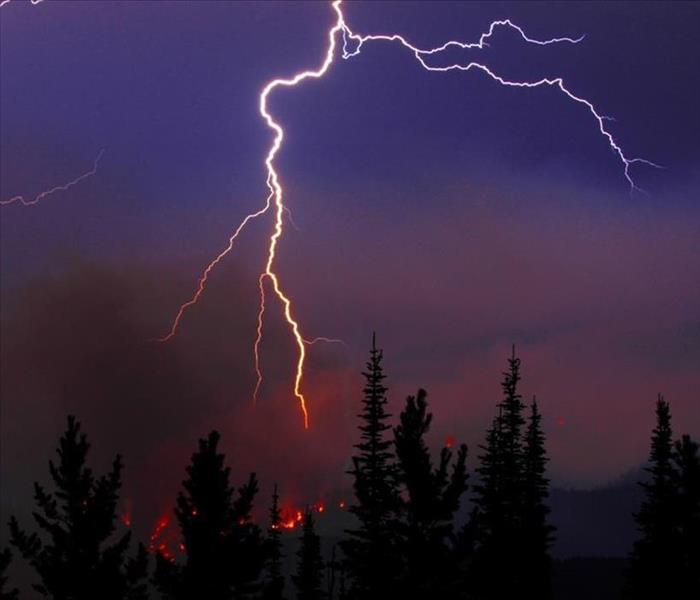 When lightning strikes near a power line, it increases the electrical current. The extra burst of electricity can lead to computer & appliance damage.
When lightning strikes near a power line, it increases the electrical current. The extra burst of electricity can lead to computer & appliance damage.
Did you know that 50% of businesses never reopen after a fire or water disaster? SERVPRO of Northern Summit County is available 24 hours a day to get YOUR business back up and running, "Like it never even happened."
Thunderstorms are absolutely something to be conscious for. 6.5% of all property claims are due to lightning strikes. Wood and other flammable building materials can easily be ignited when lightning comes in contact or passes through them. In addition, high winds, heavy rain and flooding from a thunderstorm can destroy a business in minutes.
If not prepared for a quick recovery, the lost revenue of your business could mean closure.
That is why SERVPRO has local franchises across the nation. When an emergency situation arises, call one of our highly trained professionals, certified in water, fire and mold clean up and restoration.
SERVPRO of Northern Summit County can provide:
- Over 40 years of experience as leading fire and water cleanup and restoration providers.
- There are over 1,500 franchises servicing 48 states.
- More locations for faster responses.
- Quick response time to help ensure the damage is contained and the restoration process begins promptly.
- Large loss capabilities - no fire or water damage is too big.
When the next storm hits Summit County, Ohio, call the professionals at SERVPRO of Northern Summit County - 330-650-4486, or Request Help Online.
Also consider joining our Emergency Ready Program and reduce business interruption following a disaster. Call for details.
Is Your Business Ready?
2/20/2018 (Permalink)
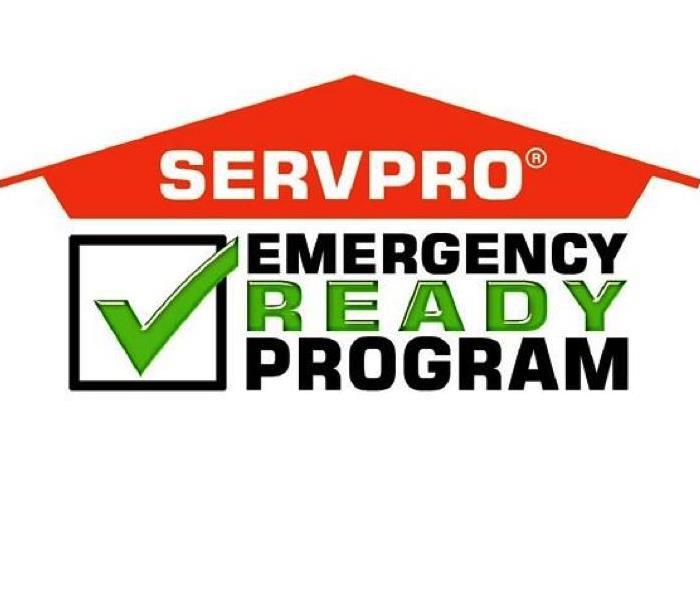 When disaster strikes, getting help is now quicker and easier using the SERVPRO Ready Plan.
When disaster strikes, getting help is now quicker and easier using the SERVPRO Ready Plan.
The best way to reduce business interruption following a disaster is to PLAN for it NOW.
The statistics uncovered by industry research say as many as 50% of businesses may never recover following a disaster. Of the businesses that survive, the majority had a preparedness plan in place.
SERVPRO's Emergency Ready Profile for YOUR business will minimize business interruption by having an immediate plan of action. With a no cost assessment of your facility, the program's profile includes your emergency contacts, all shut off valves and their locations, priority areas of your facility and more.
The SERVPRO Ready Plan provides solutions in advance of an emergency so that during the emergency you are "Ready for whatever happens."
Your business will receive the benefit of over 40 years of experience in reducing the impact of any natural or man-made disaster. Call now and take the next step in protecting and growing your business.
SERVPRO of Northern Summit County - 800-648-1212
And now with the SERVPRO Ready Plan Mobile App, help is at your fingertips. Call now and ask how to get started.
Agents: Watch Word Choice in Claims Letters
10/31/2017 (Permalink)
 Grammar matters.
Grammar matters.
The following bullets point out random errors in word choice. You may not lose a client because you make a poor word choice, but you’re not helping the relationship either. Here are several word choice issues to watch for as you phrase your letters:
- “ABC Insurance Company will make no voluntary payment of your claim…” Voluntary?
- "e.g., and i.e.," most people don’t know the difference. Use e.g., when you are giving examples; use i.e., to introduce your thought “in other words.”
- “Exception” and “exclusion” are words that have their own meanings. One adjuster wrote,” the exception that pertains to your loss can be found in your policy and is provided below for your reference. I think the word should be “exclusion.”
Here’s the difference: An insurance policy tells you what is covered.
Exclusions are classes of items that are not covered, such as nuclear war, acts of God, or terrorism. Exceptions are “exclusions to the exclusions, reinstating particular items within a whole category that had been “excluded.” For example, a homeowner’s policy may have an exclusion for all motorized vehicles. The exception to that exclusion might be a lawnmower, because a mower helps service the premises.
- “Said” – Very legalistic: “Said payment would allow you a discount of $300.” Just write, “This payment would allow you a discount of $300.”
- “Regard” and “Regards.” Do not write, “This is in regards to…” Write, “This is in regard to…”
- “Were” and “was.” Take the phrase, “If there were no coverage…” Using “were,” known as the subjunctive mood in English, represents situations contrary to fact.
- “Confirm.” When you confirm a lunch date, you restate your agreement as to the time and place. In insurance, however, it’s common to see a claims letter that starts, “This will confirm my phone call of 4/11/17." But what does “confirm” mean? Is the writer summarizing the previous call? Documenting it? Confirming is something you do to re-check a future date or agreement.
- “Advise.” About 80 percent of the time claims people use “advise,” they just mean “tell” or “inform.” No need to use “advise” in a sentence like, “Let me advise you that it will rain today.” There is no “advice” being given. However, if you write, “Let me advise you to bring your umbrella,” you are using “advise” correctly.
"Your grammar is a reflection of your image. Good or bad, you have made an impression, and like all impressions, you are in total control." -Jeffrey Gitomer
Defending Your Family Business Against Fraud
10/26/2017 (Permalink)
 Fraud can occur anywhere within a company and the right controls can limit its successful execution.
Fraud can occur anywhere within a company and the right controls can limit its successful execution.
In a study done by the Association of Certified Fraud Examiners (ACFE), the 2016 Global Fraud Study found that "businesses with fewer than 100 employees, which are in many cases family-owned, experience fraud at a rate of 28.8%, compared to the 19.8% experienced by those with more than 10,000 employees."
Smaller business often suffer more from fraudulent activities. It's more difficult to manage the damage it causes in a $5 million company than a $250 million company. This kind of activity also damages the company culture.
The median fraudulent loss suffered by small organizations is the same as large organizations: $150,000. However, while it is the same number, this number takes up a larger percentage of the small business revenue.
Here are 5 ways to defend your small business from fraudulent activities and enforce internal controls:
- Segregate financial duties. Create a three-person system of checks and balances: one person opens the bank statements, one prepares the bank reconciliations, and a third reviews all transactions and canceled checks.
- Stay away from signature stamps. Family and small businesses should require two signatures for any payment over a certain monetary amount.
- Establish routine checks of payroll, supplier and vendor lists by multiple people within the company. The final payroll list should be reviewed by someone other than the person distributing checks and preparing the payroll, and the list of vendors should periodically be checked for unrecognized names.
- Educate employees on financial reporting. To increase levels of security, outsource your financial reporting and ensure someone is monitoring for fraud.
- Every employee — including family members — should understand protocols in a business from expectations to pay rates and benefits. Clear expectations help avoid a power struggle and will clearly define who is double-checking various aspects of the business.
Fraud can happen anywhere. The more you believe it won't happen to your business, the more susceptible you become to it.
Source: 5 Ways to Defend Your Family Business Against Fraud by Bill Kowalski
Winter is Coming: Prepare Your Business for Winter
9/5/2017 (Permalink)
 A winter storm can bring with it sleet, ice, high winds, and heavy snow, which can result in sudden unexpected commercial property damage.
A winter storm can bring with it sleet, ice, high winds, and heavy snow, which can result in sudden unexpected commercial property damage.
September has arrived
and, before we know it, so will Halloween, then Thanksgiving, and then the holidays. Is your business ready for the frigid temperatures, the heavy snowfall?
According to Leavitt Group's article, Prepare Your Business for Winter Weather, In the past five years, 15 percent of small businesses have experienced damages caused by water and freezing. The average cost of these claims is $17,000.
Leavitt Group also discusses common types of winter-related damages, including:
- Damage to contents, inventory and equipment caused by significant temperature changes.
- Water damage caused by pipes freezing and bursting.
- Wind damage to roofs, buildings and landscape.
- Fire suppression efforts delayed by inaccessible fire hydrants (covered by snow or ice)
- Frozen fire suppression sprinkler pipes, resulting in flooded rooms and malfunction of system.
- Ice damming, resulting in damage to roof and gutters.
- Injury to guests and employees.
- Loss of revenue (business interruption).
Taking preventative actions now while the weather is still warm is incredibly important and could save you business a lot of time and money. Here are some maintenance tips Leavitt Group suggests in preparing your business for winter:
- Drain water from all systems and equipment not needed in winter months, including landscape sprinklers and air conditioning units
- Check for and repair damages to the roof. Make sure roof drains are clear and in good condition. Clear rain gutters to ensure proper drainage and make sure downspouts are intact and draining in areas away from foot traffic
- Inspect the exterior of the building for gaps and seal appropriately to prevent weather and critters from getting inside
- Trim tree branches and lanscape that might come in contact with the building in the event of heavy snowfall and ice accumulation
- Make sure the heating system has enough fuel for unexpected conditions and a back-up in case of emergency
- Maintain a temperature of at least 45 degrees Fahrenheit in unoccupied facilities, attics and basements
- Make arrangements for snow removal with a reputable company before winter starts- don't wait until the storm hits and you are buried under a pile of snow. Discuss snow removal from the roof. To avoid damages from snow removal equipment, mark curbs, fire hydrants, drains, speed bumps and other features that may not be visible under a layer of snow
- Make sure you have sand, ice melt and shovels on hand for winter maintenance that won't be covered by your snow removal contractor
Begin checking off your maintenance needs while the weather still allows for it. Stay tuned for our next blog for commercial property owners, "Developing a Business Continuity Plan for the Winter Weather."
Have questions? Call our office at 800-648-1212 or our 24/7 Emergency Service number at 330-650-4486.
Cybercrime From An Insurance Perspective
8/1/2017 (Permalink)
 IBM estimates businesses are attacked about 16,856 times a year- 46 attacks per business per day, nearly two attacks per hour.
IBM estimates businesses are attacked about 16,856 times a year- 46 attacks per business per day, nearly two attacks per hour.
We've heard the stories. Cyber hacks influencing the presidential election, ransomware attacks across the globe. We might even think the hackers are winning the war- the cyber war, that is.
Insurance Business America discusses this matter with an insurance perspective in a recent article, interviewing James Shaheen, cyber risk practice leader at Integro.
According to Shaheen, with every attack, our cyber security experts learn something new, and counter every attack with a defense. It will take us some time, though, to figure out what we need to implement, where the gaps are in the security, to fully protect our data.
When it comes to insurance, Shaheen believes we are doing well in the protection of Protected Health Information (PHI), Personally Identifiable Information (PII) and the Payment Card Industry (PCI), but the concern is what he calls "second-tier data."
Second-tier data, or trade secrets, is what drives businesses, and is also what is not well protected by insurance from these cyber attacks.
Shaheen claims at Integro this is an issue being addressed and developed. How much would such a development be worth to your business?
To read Insurance Business America's article and for related stories, click here.
Creating a Killer Facebook Ad Campaign for Your Business
6/20/2017 (Permalink)
 Another option would be to invest tens of thousands in expensive branding... Facebook allows you to start your marketing budget at just $5.
Another option would be to invest tens of thousands in expensive branding... Facebook allows you to start your marketing budget at just $5.
Marketing on Facebook doesn't have to be confusing and intimidating. Here are some things to consider when developing your Facebook Ad campaign, a simple and straightforward strategy that will expose your message to your ideal market and present a relevant message that drives prospects to take action:
- Target your audience. Identify your ideal client, find people who had had “liked” groups related to the subject, target a specific ZIP code or individuals who fall between certain ages. Facebook allows you to filter these and more demographics.
- The ideal budget. Facebook allows you to start your campaign budget at $5. As you progress, so can your investment.
- The perfect Facebook Ad. What should it look like?
- Don't mention pricing. Studies show that ads without price have 10% higher conversion rates.
- Add a face to the ad.
- Choose images that show the desired result of your clients, where they will be after your work.
- Test Red vs. Blue. Studies also show ads with red and blue have 20% higher conversion and click-through rates.
- Use a "call to action" button, such as "Apply Now."
- Where should the clicks go? You do not want to send your prospects to the home page of your website. Direct your traffic to a landing page where they can download a report, where the only action they can take is the next step in the process.
For details and graphics on this subject, click here to read the main article.
The SERVPRO Emergency Ready Profile (ERP)
6/1/2017 (Permalink)
Ready Plan | SERVPRO Ready Plan
As many as 50% of businesses close down following a disaster, according to the latest research. Of the businesses that survive, the overwhelming majority of them had a preparedness plan in place. Pre-planning can serve as an insurance policy aimed at peace of mind, and knowing you are "ready for whatever happens" speaks trust to your clients and employees that in the event your business is affected by a disaster, they don’t necessarily have to be.
By developing a SERVPRO Emergency READY Profile for your business, you minimize business interruption by having an immediate plan of action. Knowing what to do and what to expect in advance is the key to timely mitigation and can help minimize how water and fire damage can affect your business.
- A no cost assessment of your facility. This means there is no need to allocate funds, giving you a great value at no cost.
- A concise Profile Document that contains only the critical information needed in the event of an emergency.
It will only take a little time to complete and will not take you away from current projects. But it will save a lot of time if ever needed.
- A guide to help you get back into your building following a disaster.
This can help minimize the amount of time your business is inactive by having an immediate plan of action.
- Establishes your local SERVPRO Franchise Professional as your disaster mitigation and restoration provider.
You have a provider that is recognized as an industry leader and close by.
- Identification of the line of command for authorizing work to begin. This saves time so we can begin the work of mitigating the damage which can save you time and money.
- Provides facility details such as shut-off valve locations, priority areas and priority contact information. Having a quick reference of what to do, how to do it and who to call provides solutions in advance of an emergency so that during the emergency you are "Ready for whatever happens."
Restoring Your Northern Summit County Commercial Property After A Water Damage Event
10/13/2016 (Permalink)
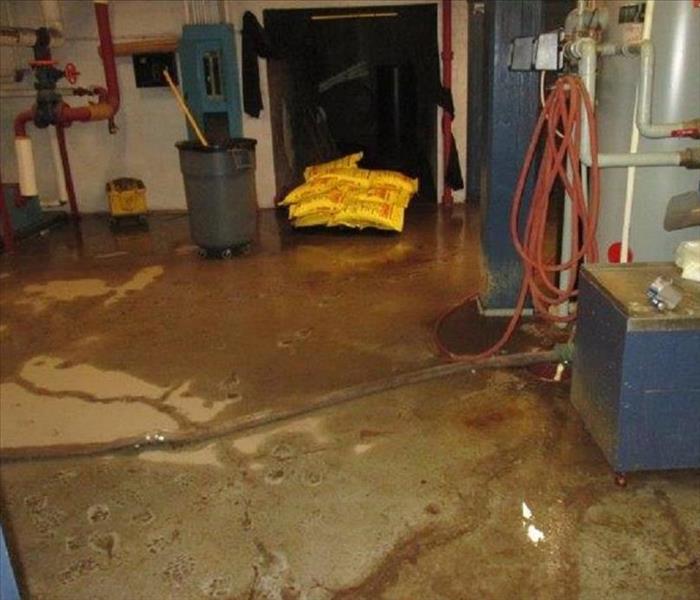 Commercial Water Damage Events Present Unique Challenges
Commercial Water Damage Events Present Unique Challenges
Flooding and water damage events at Northern Summit County commercial properties are often complex with numerous issues that require a knowledgeable and flexible response. Whether we’re dealing with a relatively small water cleanup scenario or a large scale event, we work quickly to assess each unique situation and isolate the damaged area. In many instances, normal operations can continue in a temporary space while we restore your facility.
Restoring Commercial Properties Presents Unique Challenges
Our professionals are trained to be mindful of legal and environmental concerns and strive to fully restore the damaged area while working within your budgetary constraints. We understand that every hour spent cleaning up is an hour of lost revenue and productivity. So when an emergency situation arises in your business, give us a call and we’ll be there fast with the help you need.
 In the fast-paced world of commercial businesses, unexpected emergencies can strike at any time.
Even the best trained staff needs a simple plan.
In the fast-paced world of commercial businesses, unexpected emergencies can strike at any time.
Even the best trained staff needs a simple plan.






 24/7 Emergency Service
24/7 Emergency Service
